Text
Alien: Romulus
I had very high hopes for what Fede Alvarez could do with the psychosexual terror at the heart of Alien. Instead, we get a collection of fan service (oh, here’s the famous shot of Ripley and the Xenomorph from Alien 3, and here’s “Get away from her, you bitch” except it’s said by a Black actor this time, also here’s an AI actor atrocity wearing the face of an actor from Alien, and could we interest you in a couple of references to Prometheus) and absolute nonsense at the climax. David Jonsson makes the most of his role, and he’s the only actor with a character who gets an actual arc.
I really thought that showing how the Company grinds down the young had a lot of potential, and that would make the YA feel of the movie work. Instead, we fall into the YA trap of characters who can be distilled into one-word descriptions (pregnant, bland, Asian, cousin).
One of the most disappointing movie experiences of the year.
2 notes
·
View notes
Text
In the Earth
It’s ballsy of Ben Wheatley to make a movie in 2021 during quarantine. It’s even gutsier to open with vague references to a pandemic and all the visual markers of the COVID-19 quarantine without slamming the relevance home (but with tasteful plausible deniability) like Songbird. Using the time to make a folk horror movie that tests the boundaries of viewer photosensitivity is in itself, a bold move.
And to Wheatley’s credit, there is one really good scene built around two men, a woman, an axe, and some toes. But the rest of it - the walking through the woods, the philosophizing about communicating with nature through science vs. with the spirit of nature with art, the ecological theorizing - is bunk.
#in the earth#ben wheatley#reece shearsmith#joel fry#ellora torchia#hayley squires#folk horror#horror#films#movies
2 notes
·
View notes
Text
Cuckoo
Well, I saw this week a stylish horror movie starring Maika Monroe, who broke out in The Guest, so I had to round out the week with Dan Stevens, her costar who also broke out with that film.
Where I felt that Longlegs had a really hard time escalating its tension after creating a very creepy atmosphere, I found Cuckoo skillfully ratcheting the tension from setpiece to setpiece until its really entertaining conclusion.
Hunter Schafer has drawn comparisons to Monroe since they’re both blonde, tall scream queens who bring a lanky, athletic physicality to their roles. She conveys Gretchen’s teenage sullenness and vulnerability, and she makes Gretchen’s switch flip to appreciate and protect her sister mostly make emotional sense. I’ve seen her now in a vignette in Kinds of Kindness and this film, and I’ve been impressed both times.
Dan Stevens is as weird and charismatic as ever. His conventional handsomeness helps him hide his character’s sinister oddness really well, and he commits to the performance.
The plot and the nature of the monster don’t make a ton of sense if you dig any further. I suppose that I didn’t care to dig since I was satisfied with how the film laid out its scares so well at the start and connected the dots for Gretchen’s story. If some pieces (like what was the deal with Gretchen’s father and stepmother) got lost, it’s fine.
3 notes
·
View notes
Text
Longlegs
Can a thriller be scary if it doesn't even try to hide its cards? Can you justify the obvious twist through conjectural justification that the obviousness is the point to building the dread of the inevitable? Is that just giving a movie that fumbles how it handles the third act revelation too much credit?
I went in wanting to like the film first off of the strength of the marketing and second off of my affection for Maika Monroe. Monroe plays FBI special agent Lee Harker with a twitchy distance that reads as neurodivergence. She gives Harker a presence, and her lankiness makes sense with Harker's personality. Unfortunately, Monroe isn't given much to show Harker's interiority. The film is structured for comparison with The Silence of the Lambs and thus Monroe's Harker with Jodie Foster's Clarice Starling, and though we see more of Harker's past, we get less insight into how Harker navigates the world around her. Harker's relationship with her job and her superior, Agent Carter, never rises beyond perfunctory.
There is a lot of effective, creepy mood-establishing camerawork from director Osgood Perkins and cinematographer Andres Arochi, and the costuming and set design have a lot of retro tactile charm. There is a purulent yellow filter over the film, and even the Satanic panic that the film takes absolutely serious resonates with the moral panic I remember over Magic: The Gathering's very existence and cards like Demonic Tutor and Unholy Strength. Kiernan Shipka returns to collaborate with Perkins again after The Blackcoat's Daughter and gives an unsettling performance.
There is also the Nicholas Cage-shaped elephant in the room. I found his character more silly than scary, though Cage devotes himself fully to the performance. It feels like he's channeling his audition for Jeremiah Sands from Mandy in his performance here.
Returning to the earlier question, I don't think Perkins intends to use the lack of mystery as a way of generating the dread of the inevitable. Perkins's script positions the revelation as a significant event for Harker and the film, and the way the revelation is told to us feels like we are supposed to be taken off guard by it. Instead, due to the economy of characters, there isn't much doubt about who the murderous accomplice is.
That said, the obviousness plays into the straightforward way that the film treats Satan's power as a force in the world. We are not invited to doubt that a demonic power is causing the family annihilators to murder their families throughout Oregon. There is something refreshing about that, but that's just not enough.
#longlegs 2024#longlegs movie#osgood perkins#maika monroe#nicholas cage#oz perkins#movies#films#horror
2 notes
·
View notes
Text
Kinds of Kindness
Kinds of Kindness (2024, dir. Yorgos Lanthimos): After a couple of films geared more toward mainstream tastes (The Favourite, Poor Things), Lanthimos (and long-time screenwriting partner Efthimis Filippou) are back with one for the Lanthimos sickos. I thought it was one of the funniest movies I've seen all year, and I'm glad I wasn't the only one in the theater laughing. It has the Lanthimos trademark themes of control, degradation, sudden violence, askew English phrasing, and identity.
0 notes
Text
Suffs
Suffs (2024, The Music Box Theatre): I don’t know if the comparisons to Hamilton that have thrown around in reviews have done the show any favors. It’s an easy comparison to make:
-award-winning musicals that transitioned from off-Broadway to Broadway runs
-helmed by a singular vision
-inspired by a book that the creator read about a moment in American history
-where characters are played by actors who look and speak differently than their historical counterparts.
Obviously, these two works must be paired in conversation. And since the 1776 revival flopped on Broadway after trying some of the same casting tactics as Hamilton (casting all female, transgender, and non-binary actors as the American Founding Fathers), it fell on Suffs, at least to the public, critics, and producers, to prove that Hamilton wasn’t a singular event and that you could make a commercially and critically successful musical based on American history with ahistorical casting. (As I said, the comparison is superficial.) (Furthering the narrative, Phillipa Soo was original cast in Hamilton and in the off-Broadway cast in Suffs.)
Digging below the surface, one can see similar bones upholding Hamilton and Suffs inherited from ancestors like Les Miserables. The story is mostly focused on the brash Alice Paul/Alexander Hamilton, who is contrasted against her more conservative colleague, Carrie Chapman Catt/Aaron Burr. Paul is buoyed by her three friends: Doris Stevens, Inez Milholland, and Ruza Wenclawska/John Laurens, Hercules Mulligan, and the Marquis de Lafayette. Their uphill struggle to gain women the vote is opposed by the tyrannical President Woodrow Wilson/King George III, who has a signature solo in each act. Paul and her colleagues encourage each other to finish the fight/not throw away their shot, and the musical is as much an exhortation to the present and future as much as it is a walk through the past.
And yes, we thus have the setup for easy, smirking barbs about how the one credited to a man about a man’s story is one of the most successful, critically acclaimed musicals in history while the one credited to a woman about women just won two Tony Awards and won’t see any productions in other cities, much less other countries, any time soon.
Beyond that jab, however, is the follow-up uppercut that Hamilton is just a better musical than Suffs. Many actors are making their Broadway debut in Suffs, and you can feel the rawness in the simple choreography (likely affected by the period-appropriate costuming). The play launches jarringly with the ensemble number “Let Mother Vote;” there wasn’t even a reminder to the audience to silence their cell phones to prime the audience, and so of course a phone rang in the second act. The pace fails to give the audience a moment to cheer for the first Woodrow Wilson solo, “Ladies;” instead, the scene transitions right into “A Meeting With President Wilson.”
If we fall into the compare and contrast game, then one might hold Suffs wanting in its lack of songs that stick and work outside of its context; there are no displays of verbal gymnastics like “Satisfied” or “What’d I Miss.” I struggle to hum a melody from Suffs the morning after; I would say that it’s surprising that Suffs won the Tony Award for Best Original Score, but that is also dictated by the level of competition this year.
That’s not to say Suffs is a bad musical; the house was packed for the performance I attended, and I was moved by the story and songs. The American suffrage movement presents fewer moments of bombast compared to the American Revolution and the country’s founding; there’s no Battle of Yorktown to provide a first act closing number. Instead, we have a great and fiery number in the second act focused on the Silent Sentinels, who protest Wilson’s unwillingness to publicly support suffrage and decision to incarcerate Paul, Smith, Burns, and Wenclawska at Occoquan Workhouse.
The cast is strong across the board; standouts were Hannah Cruz, who embodies Inez Milholland’s magnetic personality; Jenn Colella, who gives needed nuance to Carrie Chapman Catt, Grace McLean, who delights in chauvinism and convenient ignorance; Emily Skinner, who lights up the stage as socialite Alva Belmont; and Lucy Bonino who lends a quiet strength and anchor to the show as Paul’s closest friend, Lucy Burns.
And then there is Nikki M. James, who is incredible as Ida B. Wells. Wells is the focal point of Suffs’ departure from comparisons with Hamilton, as how the show directly challenges how the suffrage movement justified compromises to placate southern members at the cost of Black activists seems to be in conversation with how Hamilton tried to make the slave-owning George Washington an abolitionist in “Yorktown (The World Turned Upside Down)” by having him answer Laurens’s question:
Laurens: Black and white soldiers wonder alike if this really means freedom
Washington: Not. Yet.
Though Paul is Suffs’s protagonist, Suffs also shows how Paul’s story intersects with Wells’s. The play sides with Wells when she directly criticizes Paul and friends for asking Black activists to wait their turn on racial justice without resolving their hypocrisy. The suffragists who demand that the men who control their political and economic lives stop deferring to hear their call for suffrage because tariffs, war, and campaigning for re-election take priority then tell the Black activists that actually enforcing Black men’s suffrage and stopping lynchings must wait until women’s suffrage has been won. However, Suffs has a refrain on this as well: it’s important to remember who the actual enemy is and not to succumb to these divisions that only benefit conservative forces that want to preserve the status quo.
The play mostly handles these transitions in focus with deftness, and James is able to balance steely resolution, doubt, righteous indignation, sorrow at the future, and hope for the best in her limited time on stage. The play would be greatly diminished if James’ Wells, Anastacia McCleskey’s Mary Church Terrell, and Laila Erica Drew’s Phyllis Terrell had been excised so the focus could be solely on Paul’s story.
Similarly, the play reminds us of how little we know and see about the larger story of the suffrage movement and intersectional need for change by dropping a last moment revelation that Catt was queer and romantically involved with Molly Hay. It might seem like a random point to include in “If We Were Married (reprise),” but it reinforces the point that suffrage is just one direction of necessary change and that our focus on Paul limits what we know about the other activists’ motivations and struggles.
Given the high cost of Broadway tickets (our seats were in the theater’s penultimate upper tier row, and they were still more than $100), we have to be very selective in what we see. Recommendations from Helen Shaw of New York magazine haven’t steered us wrong yet, and we’re glad that we saw Suffs on her advice. If nothing else, it’s led me to teaching myself about the suffrage movement, since my formal schooling was woefully inadequate on this subject.
4 notes
·
View notes
Text
A Quiet Place (2018) and Hereditary (2018)

Trailer for A Quiet Place

Trailer for Hereditary
When the world around you petrifies you with scenes of banal evil, it’s hard to say that a horror film will be the scariest thing that you’ll see this year. After all, what could Ari Aster, writer and director of Hereditary, or John Krasinski, writer (along with Bryan Woods and Scott Beck) and director of A Quiet Place, produce in their horror films about families that would be more shocking than footage of children, forcibly separated from their parents, locked in cages, wailing for their families or at least a friendly and familiar face?
It’s a common notion that art reflects its context, and that horror films provide a particular filter for a culture’s anxieties. What anxiety drives these two films from this wave of “art-horror”? Judging from A Quiet Place and Hereditary, the pressure is on the family unit, which is besieged from within and without. It’s just that Aster has a very different perspective on the family’s odds of making it than Woods, Beck, and Krasinski.
At its heart, the Abbotts in A Quiet Place are a functional unit even though they’re coping with what could be a crippling loss. Father and son go fishing to provide dinner; mother and daughter clean clothes and manage the Abbotts’ home. As Lee Abbott, the muscular Krasinski is a loving, attentive, and infinitely patient father, stoically bearing his teenage daughter’s scorn, probing the airwaves for other survivors, fiddling with hearing devices so the scornful Regan’s hearing can be restored, and dancing with Evelyn, his pregnant wife, played by Emily Blunt. The Abbotts bear the grief of losing their youngest son, Beau, to creatures that hunt by sound, attacking anything that’s louder than a breeze’s murmur. The creatures have devastated the world, leading to apocalyptic breakdowns in civil society. The Abbotts have weathered the violence and have carved out a sustainable life in this world. Things are stable enough that Evelyn can try to home school her son, that they can build systems and contingencies to account for the impending birth of Lee and Evelyn’s child. With a larger support base of four people, they’re more capable of surviving in this world than the crazed old man that Lee and his son, Marcus, meet in the forest. In a world where Lee cannot express himself openly above quietly mouthing words to his family, Lee tells Regan and Marcus in American Sign Language that he loves them before he yells at one of the aforementioned creatures to ensure Regan and Marcus’s to take care of their mother and new brother. His sacrifice and tinkering with hearing devices allows Marcus, Evelyn, and Regan to discover the secret to killing the creatures. The film ends with what viewers actually wanted to see all along: a character played by Emily Blunt cocking a shotgun, ready to blast away any threats to her family.
A unified and functional nuclear family, the Abbotts can do it all. They find the secret to destroying the threat, which no one was able to discover. They destroy one of the creatures, which even organized militaries with superior logistics and firepower couldn’t manage. The trauma within their family unit pales in comparison to the existential external threat, so it doesn’t have the chance to corrode their bonds. They not only survive in this world; they thrive so successfully that they are able to conceive the notion of replacing their dead son with a new baby and to countenance the idea of raising a screaming, crying baby in a world torn apart creatures that hunt sounds. They believe that they control their own fate, that every obstacle can be overcome, that their love for each other is enough to carry them through this crisis. All they’re looking for, if you will, is A Quiet Place.

From Looper to Edge of Tomorrow to A Quiet Place, sometimes you just need to see Emily Blunt brandish a gun.
[As with other horror films, Hereditary’s power comes from its ability to surprise. So, spoilers ahead for Hereditary.]
The Grahams in Hereditary (Toni Collette’s Annie, Gabriel Byrne’s Steve, Alex Wolff’s Peter, and Milly Shapiro’s Charlie) have a quiet, suburban home, but they lack the luck that the Abbotts have. Where the Abbotts are unified, the Grahams are quietly disintegrating, unacknowledged grievances eroding their ability to communicate with, much less trust in, each other. Aster at first encourages us to accept that the corrosive agent is a history of mental illness in Annie’s family: Annie tells us by telling her grief support group that her father starved himself to death; her brother had schizophrenia committed suicide; her mother had dissociative identity disorder and developed dementia in her twilight years. Later, Aster shows Steve drafting an email to a psychiatric institute to express his concern that Annie, possibly not for the first time, is having a mental health crisis. The film’s marketing works hard to lead us to think that the film will be Annie’s descent into madness as her sanity slips thanks to stress and a genetic predisposition toward mental disorders. Instead, the threat that the Grahams inherited is much older, and unlike the Abbotts, there is no last-minute discovery of a secret that will allow them to blow the threat wide apart.
In her eulogy for Ellen, Annie described her as a secretive woman who had “private rituals” and “private friends.” Annie did not learn effective communication skills from her uncommunicative mother. Instead, Annie lies to her husband about going to grief support groups, telling him instead that she went to see movies. She channels her grief and pain into carving miniatures that depict painful moments of her life, like her mother baring her breast and trying to breastfeed Charlie in Annie’s stead, her mother slowly dying in hospice care, or the accident that decapitated Charlie and traumatized her son. She is unable to call the gallery that is expecting to show her miniatures to ask for more time; when they call her and offer an extension, she smashes the miniatures in barely suppressed and unexpressed anger and frustration. She reveals to Joan, a woman she befriends at the grief support group, that she almost burned Charlie, Peter, and herself alive one night while she sleepwalked. She describes to Joan how she and Peter settled into a cycle of blame and argument after that incident, but there are no hints that they ever sought counseling to resolve this through communication. After Charlie’s death, she rants during dinner, in a tour de force performance by Collette, that she cannot communicate with Peter because he will not acknowledge his responsibility in Charlie’s death. Unable to sleep after Charlie’s death, she lies to Steve that she’ll return to their bed. When he later freaks out because she has sleepwalked into his room, she downplays it and never acknowledges to Peter that might is rightfully upset given the last incident when she sleepwalked to him. The idea that the family should enter counseling after Charlie’s death is never considered; given that she learned to be a private and uncommunicative woman from her mother, Annie would probably reject the idea. Whereas the Abbotts could not talk for fear of their lives, the Grahams could not talk to save their lives.
Obviously, there is a difference between what you inherit and what you learn, but the bigger idea is the past’s effect on the future. While the Grahams could have overcome her lack of communication skills, they could not have overcome the demonic conspiracy that Ellen and her private friends had set in motion years ago. Aster plays his thematic hand early; in a classroom, Peter’s classmates and teacher discuss the tragedy of Iphigenia, whom Agamemnon sacrificed to gods in exchange for strong winds on the Mycenean fleet’s journey to Troy. They debate whether it is more tragic if a character causes their own downfall due to a fatal flaw or if it’s worse if their downfall was fated all along, the character stripped of their control of their possibilities. The film then allows the viewer to forget this discussion until it is grounded in the revelations about how Ellen and her circle pledged themselves to the demon Paimon.

The Grahams’ downfall is not due to the mental illness that Annie inherited from her family. Instead, the Grahams never had control at all; Ellen and her friends had arrayed the forces and circumstances to ensure that Paimon would find a corporeal home. (Perhaps Ellen tried Annie’s brother at first; perhaps that’s why he bemoaned that she was trying to “put people in him.”) Strange words and phrases ("satony," "liftoach pandemonium," and "zazas.") are written on the walls throughout the Grahams’ house, and Paimon’s symbol appears on the pole that decapitated Charlie. Steve is not related to Ellen by blood, so he would not have been a suitable host for Paimon. So, Ellen wrestles Charlie away from Annie, wishing that Charlie had been a boy because Paimon prefers male bodies. While the conspiracy to prepare Peter to be Paimon’s host, Paimon inhabits Charlie’s body. After Charlie’s death, someone, possibly Ellen’s fellow conspirator Joan, slips an invitation to a seance into the Grahams’ mail slot. The Grahams don’t attend, so Joan delivers the message to Annie herself one day when she too conveniently meets Annie outside an arts supply store. No outside forces, divine or mortal, intervene in the Grahams’ dissolution. Grief counselors and law enforcement are not concerned with the Grahams after Charlie’s death. Men of God are absent when the demonic plot becomes clear. At least Father Merrin and Father Karras get involved with Regan’s possession in The Exorcist, Katie and Micah invite a psychic to help communicate with the spirit haunting their home in Paranormal Activity, and Ed and Lorraine Warren investigate the spirit that troubles the Perrons in The Conjuring. No help comes for the Grahams; it wouldn’t matter if anyone would have because their dice have already been cast.
Aster deploys a stylistic flourish to reinforce the inevitability of the Grahams’ demise and their helplessness in the face of it. The first scene of the trailer and the film has the camera zoom in on a miniature version of Peter’s bedroom and seamlessly transitions to Steve walking in to wake Peter up for Ellen’s funeral. During Charlie’s funeral, the camera pans downward past the grieving family and into the dirt to imply that they are in a terrarium, a simulacrum of nature that is carefully constructed. Throughout the film, the camera moves horizontally, as though the viewer is viewing a diorama. Aster zooms in on miniatures and movies the camera horizontally to blur the line between the doll and the flesh and blood character throughout the film. By blurring the lines, we are cued to accept that these characters are toys for a larger, unseen, external force.
The sense of helplessness is the heart of the film’s power. We are all manipulated by larger, nearly incomprehensible external forces. Governments with a pretension toward fascism rely on the citizenry feeling cowed into submission and the thought that resistance is futile. Corporations rely on consumers believing that no alternative exists to the services that they provide. Who can realistically fight the powers that be and win? That’s the underlying anxiety that Aster is tapping to power the terror of his film.
The film’s exploration of that abstract anxiety is coupled with the raw family drama of the film’s first half and more traditional scares in the film’s second. Aster loads Chekov’s Gun with an early reference to Charlie’s nut allergy and pulls the trigger in the party scene where she eats a walnut-filled chocolate cake. As an intoxicated Peter races them to the hospital, Charlie struggles to breathe and thrashes in the backseat of the family station wagon. She opens a window and sticks her head out, hoping that the air rushing by could enter her lungs. Peter swerves to avoid a conveniently placed deer in the middle of the road, and Charlie’s head collides with a pole. Wolff is incredible in this scene, as his Peter enters a deep state of denial about Charlie’s death. He drives home and goes to sleep because there’s nothing else his traumatized psyche can manage, and the haunted look on his face as he waits for Annie to discover Charlie’s decapitated corpse in the backseat is magnificent. After Charlie’s death, the family slowly disintegrates. They try to manage with medications and denial, but their inability to communicate grinds away the relationships between husband and wife and mother and son. This first half, built around Charlie’s death and climaxing in the dinner scene, grounds the film in raw grief and is reminiscent of family dramas like Ordinary People and In the Bedroom.
The second half deploys more traditional horror film tricks, from half glimpsed shadows and out of focus scares at the periphery of the frame, to jumpstart the film’s descent into destructive, supernatural inevitability. Watching Hereditary in a packed movie theater meant that there were nervous or dismissive giggles throughout the film, but it was all worth it to hear the audience realize in pockets here and there that Annie, dominated by Paimon, was stalking Peter from the ceiling. Out of focus, the white shape of Annie, clinging to the ceiling like Spider-Man and skittering out of the frame a moment before Peter could turn his head to see her, teases the audience with the scare of when the possessed Annie will make herself known to Peter. You can try to giggle away your nervousness, fellow viewer, but I can feel your tension from here. Here, the emotional rawness of the first half collides with the horror tactics of predecessors like Twin Peaks, The Exorcist, and Rosemary’s Baby. The moment when Annie jumps out of a shadowy corner in the living room and chases Peter to the attic reminded me of when Leland Palmer, possessed by Bob, chases Maddy Ferguson in Twin Peaks, a scene which continues to haunt me. Peter’s desperate dive out of his second story window reminded me of Father Karras’s self-defenestration in The Exorcist. Peter’s ascension as Paimon’s host brought to mind the ending of Rosemary’s Baby, when the Satanic cultists exclaimed that the infant had “his father’s eyes.” Aster ends the film by pulling the camera out one more time to show Peter as Paimon and Paimon’s worshippers in the Grahams’ treehouse as though it were a diorama, and the image is blurry enough that we could think that we were seeing a set of miniatures carved by Annie about this latest tragedy in her family’s unfortunate history.
At first, I was bothered by how much I felt that the film had played a bait and switch game with my expectations. I realized that I’m more to blame for that than Aster. Aster didn’t direct A24’s marketing arm to create trailers that make me think the film is about mental illness and generational demonic possession. That surprise made the raw tension of the film’s first half more striking, which lays the relatable groundwork for the film’s supernatural second half. Aster plays fair with the viewer throughout; there are enough teases in the first half, from Annie’s initial discovery of tomes about spiritualism and Ellen’s haunting postcard that posthumously promised to Annie that all the sacrifices would be worth it, that I didn’t feel blindsided by the supernatural turn. It might feel disjointed; Annie, the film’s grieving fulcrum, meets as subdued a storytelling fate as a scene where she, levitating in the Grahams’ attic, decapitates herself with wire so Paimon can be released from her hijacked body, can ben. Because the film’s storytelling focus had been trained on her, the change in focus to Peter feels abrupt. But there’s power in the realization that the Grahams are all fated for terrible ends and that Peter has arguably the worst fate of all. At least his family members’ demises are swift. Instead, his body is stolen and his soul suppressed, if not consumed, by demonic possession. And, if that’s not the case and it’s all in Peter’s head, as the close shot of his stupefied face in the final scene implies as Joan, offscreen, prays to Paimon, then it’s not a much better end for Peter, who is left orphaned and traumatized.
Krasinski and Aster can take pride in the stylist flourishes and the games that they play with the audience in their respective debut efforts. Krasinski asked the audience to be patient with him for almost a quarter of a film in silence, while Aster led viewers through raw family tragedy before taking a turn into the supernatural. Aster used camera movements to lay the groundwork that his characters are playthings; Krasinski’s cinematography was more workmanlike, but it was effective. The sense of impotence at the center of Hereditary spoke to me more than the optimism springing from love and American pluckiness from Krasinski’s A Quiet Place. There is room for Krasinski’s optimism, and maybe it’s just as important to feel it as it is to acknowledge the external forces that oppress us at which Aster hints. In the face of how easy it would be to give up when one feels so feeble, maybe the optimism and the power of love become even more important.
#a quiet place#john krasinski#emily blunt#bryan woods#scott beck#millicent simmonds#noah jupe#ari aster#hereditary#toni collette#gabriel byrne#milly shapiro#alex wolff#ann dowd#horror
1 note
·
View note
Text
“Only what you take with you”: Extra-textual interaction with Baby Driver, mother!, and Star Wars: The Last Jedi

“What’s in there?”
“Only what you take with you.”
Months ago, I saw Edgar Wright’s Baby Driver, and I couldn’t quite explain my cold reaction to it. As the sum of its parts, it should have been a no-brainer, sure to be favorite. Its soundtrack was full of soulful tracks meticulously curated by Edgar Wright and mixed by editors and the music department. Its stunt driving was breathtaking, orchestrated by a small squadron of stunt performers. Its cast was an alchemical brew of charisma and distance, charm and menace. It should have been one of my favorite films not just of 2017, but of my lifetime of watching movies and haphazardly ranking and re-examining what I can take from them. I admired Baby Driver from a distance, appreciating the stunts, but I couldn’t feel the emotional connection to it that would have anchored it as one of my favorite films. The confusion between this appreciation for the craft and the lack of emotional connection actually kept from writing about the movie because I felt that I had nothing to say about it.

Months later, I saw Darren Aronofsky’s mother! and couldn’t wait to talk about it with the person I saw it with, with anyone who saw it, and with anyone who might be interested in seeing it. It was my mission for a few days to share my passion for this film, something I hadn’t felt since Mad Max: Fury Road. My evangelism for mother! was met by disdain from friends who had hated what Aronofsky was trying to do in that film and his execution; talking about the film with them was the most fun I’ve had in engaging with a film in a while.

Today, I saw Star Wars: Episode VIII: The Last Jedi, with an open mind and low expectations after how listless and small I felt The Force Awakens was. I started tearing up during the opening scrawl; I started sobbing quietly into my coat when Carrie Fisher first appeared on screen. The film itself had done almost nothing to earn this depth of emotion from me at that point, but I felt overcome. When I stepped out, I felt a release and peace; I had needed that experience beyond going to watch a film on a Sunday morning on a whim.

In each case, I concluded that the secret ingredient was in me all along. I didn’t connect with Baby Driver because I didn’t have the anchors to engage with it completely. I didn’t obsess over car-based action movies like Bullitt, The Italian Job, or The French Connection because I didn’t see them during my formative years. I saw them as an adult when I was trying to build a mental library of films that I could reference so I could appreciate the films that came after in context. I didn’t grow up listening to the music that peppered the film’s soundtrack. My point of connection was actually my admiration for Jon Hamm transferring the menace that laid under his performance as Don Draper in Mad Men into violence as Buddy, but admiring an actor’s performance as the film’s antagonist only got me so far. So, without the anchor, my attention was left adrift as I watched the film, left unsatisfied by the relationship between Elgort’s Baby and Lily James’s Debora that never reached the nuclear temperatures that would have provided an emotionally resonant explanation for why they would fall madly in love with each other and why Debora would be devoted to Baby through the years of his prison sentence. I admired the stunt work, but the story felt like it was going through the motions because I didn’t care if Baby was able to ferry his crew safely or survive their betrayals or if Baby would be able to escape Doc’s control. An emotional connection is what helps the viewer close the distance between their eyes and their hearts, and all I had left while watching Baby Driver was the intellectual appreciation for the craft that my brain and my eyes could put together. I’m sure Wright referenced the films, like Vanishing Point or The Blues Brothers that influenced Baby Driver, but I couldn’t play the spot the reference game because I don’t have the contextual knowledge.
With mother!, I could easily identify the game that Aronofsky was playing because he was referencing a fundamental text in Western culture. So, for the first half of the film, I was awed by the audacity that Aronofsky would try to play coy with his retelling of the Book of Genesis and trying to anticipate how he would keep playing the game when he would reach the life of Jesus Christ. I had seen depictions of the relationship between the Judeo-Christian creator God and Mother Nature before in E. Elias Merhige’s Begotten, and I spent years engaging with the idea that the books of the Bible could be treated as literature and with the idea that God could be considered the protagonist of the Biblical narrative through analyses like Jack Miles’s God: A Biography. Aronofsky combined religious caricature with the domestic comedy of a an oblivious husband, a frustrated wife, and guests who outstay their welcome. Because Aronofsky worked with a fundamental text, the film could also be open to interpretation, from a fairly straight retelling of chapters 1-11 of the Book of Genesis and a reinterpretation of Jesus Christ that would fit comfortably along side Miles’s Christ: A Crisis in the Life of God and Begotten to an environmental parable to criticism of organized religion. It could be seen as Aronofsky’s companion piece to his previous film, Noah, which focused on chapters 6-9 of the Book of Genesis, or the latest cinematic step in Aronofsky’s search for spiritual meaning that began with Pi. I am, admittedly, a fan of Darren Aronofsky’s work; we’re alumni of the same summer camp, and seeing his name is often enough to engage my interest in a film. With all these potential points of association, it was easy for me to connect my eyes, my brain, and my heart to the film.
I commented to a friend that I couldn’t believe that it’s been only two years since we saw Mad Max: Fury Road together because it’s felt so much longer. Despair can elongate the sense of time’s passing; 2017 has been full of anger and despair, so it’s no wonder that this year has felt like a decade. When I sat down to watch The Last Jedi, I was unprepared by how badly I needed something to tell me that there was still hope in resisting against oppression, corruption, and the general darkness. I could point to how nonsensical the First Order’s strategy of engagement with the Resistance was, how confusing the First Order’s actual strength of force was, and how tangential Finn and Rose’s story felt to the film’s larger narrative. On the other side, I could point to how Rian Johnson mastered the craft of giving viewers memorable tableaus, from the blinding red of Supreme Leader Snokes’s throne room to how the salt changes color as the First Order and the Resistance battle on Crait. In the end, it was the emotional charge of seeing Carrie Fisher in her last role, wondering how Fisher and Mark Hamill bore aging in front of us, lifting the weight of years to sift through memories of watching Star Wars movies and shows, reading Star Wars books, listening to the music of Star Wars that struck a chord. It was the thought of how popular culture has appropriated Princess Leia into a symbol of resistance, and how that appropriation is tied to the fact that Star Wars is an intellectual commodity marketed and sold by one of the biggest corporations in the world creates a tension that works for and against it. Roger Ebert described movies as “like a machine that generates empathy.” I recognize how silly and naive this sounds, but The Last Jedi, a film that cost hundreds of millions of dollars to make and will nearly billions for The Walt Disney Company, generated hope for me. I think Rian Johnson realizes that tension too; it’s not a coincidence that he ends The Last Jedi with a scene of a child telling two other children the legend of how Luke Skywalker stood up to the First Order alone and how that sparks one of the listener’s hope. Even if the message was made and transmitted for the sake of commerce, the power lies in how the audience receives it and what it inspires the listener to do.



In each case, the secret ingredient was what I was took with me from outside the cinema. I didn’t have the context to play the “spot the reference” game with Edgar Wright’s Baby Driver, so I was left grasping for an emotional connection. Between my appreciation for Darren Aronofsky’s films and years of thinking about religion, I was fully prepared and engaged with the game that Aronofsky was playing with the audience with mother!. And my unsuspected craving for hope with me left me unable and unwilling to nitpick The Last Jedi, to carve it up into its component parts because the sum is too great.
#baby driver#edgar wright#ansel elgort#lily james#jon hamm#elza gonzalez#jamie foxx#jennifer lawrence#mother!#darren aronofsky#javier bardem#michelle pfeiffer#ed harris#star wars#star wars the last jedi#the last jedi#rian johnson#daisy ridley#John Boyega#Oscar Isaac#Carrie Fisher#mark hamill#adam driver#begotten
5 notes
·
View notes
Text
The Big Sick (2017)

Trailer
Every now and then, I’ll meet a couple whose shared story of how they ended up together seems so outrageous or is well told that one listener will inevitably say that they could make a movie about it. It makes sense that the couple’s story is recited with skill; their delivery is refined with re-telling, and they come to know the story’s beats like they, in theory, know each other.
Here, with Emily Gordon and Kumail Nanjiani’s The Big Sick, we actually have a story about how two people ended up together that was turned into a film, with some liberties taken along the way. Nanjiani, playing a fictionalized version of himself, is charming and disarming in a low key way. His playful and deadpan nature draw you to engage with him while his murmuring delivery makes you want to listen to him even more closely. Zoe Kazan, as Kumail’s girlfriend, Emily Gardner, is vivacious. Her presence is felt by its absence during the middle of the film when she is in a medically induced coma. Ray Romano reminds us with his performance as Emily’s father, Terry, that his dramatic work is underappreciated and that his 2009-2011 television show, Men of a Certain Age, is woefully absent from the many different streaming platforms that are ravenous for content. Holly Hunter, as Emily’s mother, Beth, is her usual force of nature, intimidating but loving. Relationships are about more than one love story. They can be as much about how the couple bonded as much as it is about how people make each other’s family fall into love with them too. Because Hunter’s is so fierce, you root for Kumail to win her over as he processes his regret from breaking up with Emily.
The story is focused on Kumail’s decision to stay with Emily and support her parents as they try to stay sane during Emily’s coma, but it skips over the parts of the story that interest me most. I suppose that the film invites you to draw your own conclusions about why Emily would seek Kumail out in New York after she tells him that they can’t resume their relationship. While she was sleeping, he changed, and she couldn’t process this new information about him. We’ve spent two hours at that point with Kumail, and we saw that he and Emily made a great couple when they were together. We’ve seen his willingness to challenge the pressure from his family to follow tradition and marry a Muslim woman or be separated from his family. The film would have failed if I can’t imagine why Emily would choose to reconnect with Emily.
Instead, the most interesting part of the film is the glimpse of how the Muslim women who are scheduled to meet Kumail feel. They are invited to meet Kumail by Kumail’s and their parents in order to arrange a marriage. The first woman we meet is not named in the film; she is nervous, almost desperate to win Kumail’s approval by making references to The X-Files. Later, we are introduced to Vella Lovell’s Khadija, who impresses Kumail and his family with a magic trick. There was enough of a spark of chemistry between Kumail and Khadija that I thought that the film could explore it as one more source of tension in the story of Kumail and Emily’s relationship. Kumail’s mother invites Khadija and her family to meet Kumail later in the film, and Kumail rejects Khadija. Kumail tries to apologize and tell her that she deserves someone better than him, and she counters, in a tired voice, that she feels like a bruised apple because she has been sent to try to impress many potential husbands and that she just wants to be in a relationship so she can finally relax. The movie finds its tension in how Kumail wants to reject his family’s cultural traditions, but the most interesting story is actually in how the women deal with the pressure from their families to become married and start families. That’s a well-trod topic for romantic comedies, from 27 Dresses to other, much better romantic comedies, but the appeal comes from exploring it from the perspective of Muslim woman who has to make these appointments to meet potential husbands.
Perhaps the resolution would be as low-key as the way that Kumail resolved the tension with his family. His parents confront him after he fails to appear at a dinner to which they invited Shunori Ramanathan’s Sumera, leaving them stumbling to cover for his absence and misunderstandings about her fluency in Urdu with awkward singing and lame excuses. He finally reveals that he had been dating a woman outside of his culture and religion and that he does not pray when they think he does because he does not feel their religious compulsion. Exasperated, he asks questions familiar to adults who emigrated to the United States as children: “Why did you bring me here if you wanted me not to have an American life?” They threaten to disown him, but he rejects that threat because he doesn’t want to leave the family. The threat that hung over Kumail for much of the film is almost too easily defused; even after they disowned him, Kumail’s brother attends one of his one-man shows, while his mother and father come to his apartment to give him a meal for his trip to New York and a request to text them when he arrives. The film requires us to side with Kumail and to root for Kumail and Emily’s relationship to make the narrative choice to defuse the threat this way work and not ask why Kumail couldn’t have just as fulfilling a relationship with, for example. Nonetheless, Khadija’s story deserves to be told, even if the story about how Khadija eventually met her partner might not be so dramatic that it gets made into a film one day.
#the big sick#kumail nanjiani#emily v gordon#zoe kazan#ray romano#holly hunter#anupam kher#zenobia shroff#vella lovell#shunori ramanathan#films#movies
0 notes
Text
The LEGO Batman Movie (2017), Logan (2017), and The Fate of the Furious (2017)

Trailer

Trailer

Trailer
I’m at an age where many of my friends have become or will become parents. Since I was the first person in my peer circle to become a father, they sometimes turned to me to ask what advice, practical or philosophical, I could give about becoming a parent. By this point, I’ve refined my patter to a performance. I will consistently tell my friends, “Don’t have kids.” Either that draws them in further to inevitably ask why, or they take the words on the superficial level and move on with the conversation. If they ask why I, a father of a delightful kid, would say that, I ask if they want the practical or the philosophical reasons. The practical reasons are simple: having a child is a major financial commitment, a guarantee that you will never have a sound night of sleep ever again (and not just because an infant’s needs will interrupt your sleep), and a turning point in the relationship that you and your partner have. You and your partner’s relationship may not survive; the roles that you and you partner played in the relationship before you became parents will not be the roles that you will play after. The philosophical reasons are based in pessimism: if we accept that any actions that lead to the suffering of others is immoral, then having a child is an immoral act because human sentience means that we all live in constant pain born from a terror of knowing that our lives are finite. We are always dying. We die every second. In response to the absurd notion that we are born only so we can live to know that we will die, the most common options are: commit suicide, embrace the absurdity of life, or to recognize how absurd life is and rebel. How could you then morally justify creating life?
What could have been in the creative air to inspire three major blockbuster films (The LEGO Batman Movie, Logan, and The Fate of the Furious) from three different distributors (Warner Brothers, 20th Century Fox, and Universal Pictures, respectively) to tackle the ideas of family unity and fatherhood in three different ways? (And it’s noted that these three films offer their takes on fatherhood specifically, not parenthood.) I suppose it’s natural that someone will explore the paradoxical idea that characters like Batman and Wolverine, who are so often defined as loners who don’t believe that they deserve human connections to other people would actually have many relationships that form an extended family with characters who choose to be with them. In other words, you could imagine Batman, Wolverine, and Dominic Toretto each saluting their respective families with their beverages of choice.



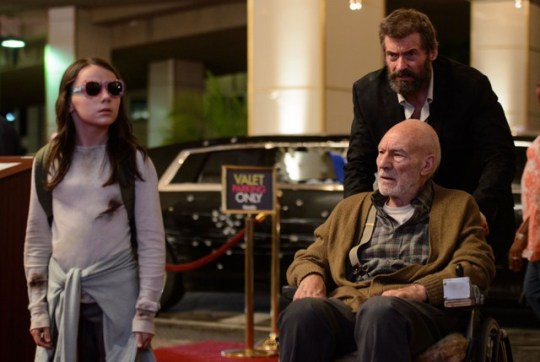
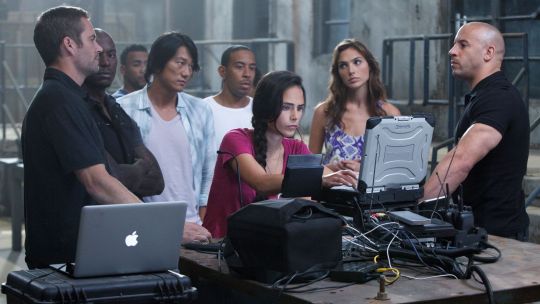
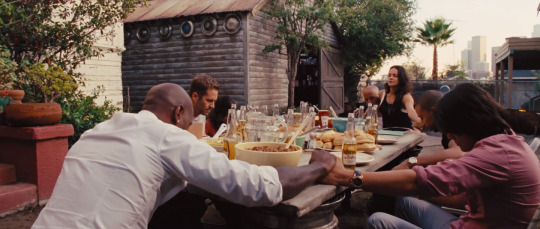
Colorful and bombastic, The LEGO Batman Movie contextualizes the characters around Batman as his extended family. From Alfred the patriarch (voice by Ralph Fiennes) to Batman (Will Arnett) to Batman’s adopted son, Robin (Michael Cera), to Batman’s co-dependent nemesis, the Joker (Zach Galifianakis), to Batman and Joker’s extended work friends and acquaintances like Harley Quinn (Jenny Slate), Barbara Gordon (Rosario Dawson), and Clayface, the many bonds that Batman has with the world around him are highlighted in bright neon explosions. As Batman’s surrogate father and like a father who worries about his kid’s ability to make the right kind of friends at school or meet the right partner, Alfred worries about his charge’s ability to form social bonds that will sustain Batman if he were to ever die.

The film’s inciting incident is Batman breaking the Joker’s heart by telling him that he means nothing to him; the movie ends with a play on romantic comedy beats by climaxing with Batman and the Joker telling each other that they hate each other. It’s the psychosexual dynamic between the two that Frank Miller famously explored in The Dark Knight Returns and Scott Snyder years later in “Death of the Family” sanitized for the elementary school set.



The cinematic versions of Batman always come around to embrace the idea that Batman isn’t the loner that he thinks he is. He travels with gods like Superman and Wonder Woman. In The LEGO Batman Movie, he craves the attention from his peers in the Justice League so badly that he has to put up a front to pretend that he doesn’t want it when he doesn’t get it. In other films, he actually founds the Justice League.
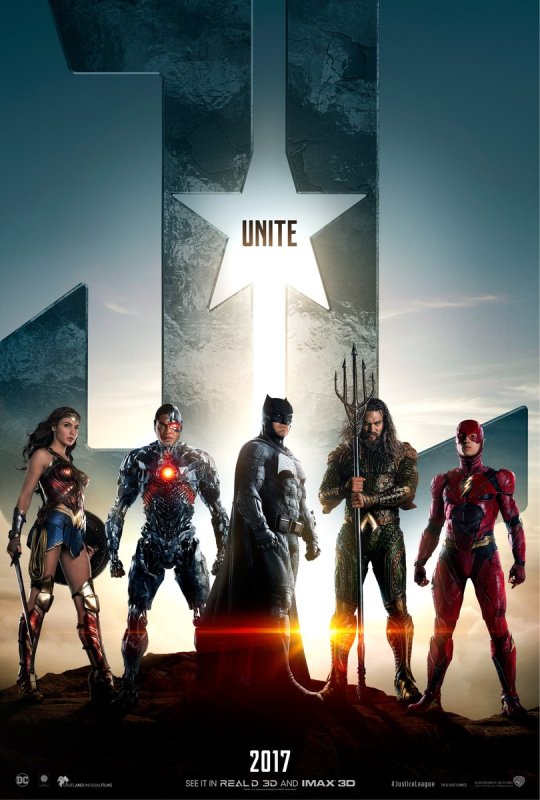
He’s also a father figure, whether in the figurative sense (Batman’s vigilantism gives birth to a more demented class of villains, and his rogues slowly transition from mobsters to supervillains) in a more literal sense (Batman becomes the guardian to the various Robins over the years and the central figure in a cohort of vigilantes, from the Huntress to Spoiler to Red Hood to Batwoman to Batwing). Michael Cera’s performance as Robin in The LEGO Batman Movie makes the character guileless and eager to please than normal to contrast with the bravado that Will Arnett infuses into his Batman.
Like his bald counterpart in The LEGO Batman Movie (coincidentally portrayed by Ralph, another Englishman, Fiennes), Patrick Stewart’s Charles Xavier is concerned that Logan (Hugh Jackman) will lose his chance to reforge a connection to the wider world around him in Logan. Bitter, broken-hearted, and betrayed by his body, Xavier insists to Logan that there is still time for him to reconnect with the world after the rest of the X-Men were killed when Logan meets Laura (Dafne Keen). Logan, Laura, and Charles’s adventure across America remind Logan what a warm household full of affection, as the X-Mansion might have been once, looks like compared to the dusty and solitary existence he, Caliban (Stephen Merchant), and Charles lived in Mexico as he tried to raise enough money to go somewhere so he and Charles can die in peace. As Logan undergoes this journey and reforges connections, he travels from a dusty broken down industrial plant to a neon-bathed city to a corn farm and back to nature, his soul undergoing a revival even as his body continues its breakdown.
Both Logan and Batman begin their films as reluctant fathers, each haunted by loss and unable to figure out the hedgehog’s dilemma. Both are convinced that their lonely lives are the only ways that they can pass their days. Both are pushed by their surrogate father figures to bond with children who unexpectedly enter their lives. And both try to demonstrate their acceptance of the responsibility of fatherhood through sacrifice. Logan overdoses on a drug in order to protect Laura and her friends from a physical avatar of his wild past, while Batman volunteers to return to the Phantom Zone to honor the agreement he made with the Phantom Zone’s keeper that allowed him to return to save his fledgling family.
There’s a thrill to seeing Logan cut a bloody swath across the screen, but the film’s melancholy gives it a bitter taste. The shock of Logan cutting off an arm from a man who was trying to steal the tires from his rented limousine is undercut by how hard it was for the legendary Wolverine to fend off those four men. The excitement of Logan bearing his claws at Donald Pierce (Boyd Holbrook) and the Reavers is undermined by how ineffectual Logan is against them. You might be surprised that Logan is casually murdering Reavers who were trying to capture Xavier, but the surprise is subverted by the realization that the Reavers were completely defenseless and neutralized by Xavier’s psychic seizure. Logan facing down goons to help Will Munson (Eriq La Salle), a farmer that he helped on his journey, but his violence against the Reavers and the goons only brings more violence upon the Munsons, which leaves them all dead. In the climax, Logan is temporarily restored to his former vitality due to a healing serum, but by the end of that burst of violence, Logan can barely stand. Violence in Logan is a bittersweet fruit.

Every time Logan fights the Reavers, they come back with more and stronger soldiers. When he faces them in Mexico, the Reavers have heavily armed Mexican police officers riding in SUVs. By the time that he faces them in North Dakota, the Reavers have armored trucks, jeeps with mounted machine guns, and a young feral clone of Logan. Nonetheless, Logan can’t help but feel fatherly pride during the climactic fight against the Reavers. Laura had already saved him once after he collapsed on the side of a highway by getting him medical attention. But he becomes proud of her when she fights to defend her friends against the Reavers, and they coordinate their attacks. They bond through violence because, as Xavier said, they’re very alike.

The price of violence makes explicit the idea that becoming a parent raises the stakes. One might be tempted to quit an unsatisfactory, unfulfilling, underpaying job, but the income or health insurance from that job might be the only thing that protects your family from deprivation. One might be tempted to lash out at the world or to go it alone, but that might be the selfish thing to do.
James Mangold, the director of Logan and one of the screenwriters, along with Scott Frank and Michael Green, unintentionally struck political relevance in the current political climate. The film’s development began in 2013, and the screenplay was complete by early 2016, around the same time that Donald Trump was campaigning for President of the United States on a platform of xenophobia and racism. In the film’s opening scenes, we see Logan chauffering four young white men past a Mexico-US border checkpoint. They’re standing through the limo’s sunroof, chanting “USA!” at the immigrants waiting to pass the border. By March 2017, President Trump’s administration is floating trial balloons to test the idea of separating women and children who are caught crossing the Mexico-US border together. Laura and her friends are Mexican children whose humanity has been denied by a corporation so they can be experimented upon and trained to be weapons. As Donald Pierce references repeatedly throughout Logan, Laura and her friends are commodities, patented intellectual properties of the company that employs him. Whereas other X-Men stories would be metaphors about how the Other is demonized, here the Other is completely dehumanized. Principal photography for Logan ended in August 2016, but the idea that Laura and her friends are not seeking refuge in the United States because the United States is not a hospitable place for children born from Mexican mothers and the image that they are running toward the Canadian border to seek asylum make for accidentally potent juxtaposition.
While The LEGO Batman Movie and Logan present their protagonists in trigenerational families, The Fate of the Furious presents two different types of families. There’s the circle of friends that become a family that Dominic Toretto (Vin Diesel) often toasts with a bottle of Corona. Then, there’s also the son that he and Elena (Elsa Pataky) created during their relationship when he thought that Letty (Michelle Rodriguez) was dead. Dominic accepts fatherhood without reservation and is willing to betray his la familia in order to protect his biological family until he can find a way to save his son from Cipher (Charlize Theron, mostly underutilized in the film), a legendary cyberterrorist who is blackmailing Dominic to steal an EMP device, a Russian nuclear football, and a Russian nuclear submarine for her.
There is, of course, another father in la familia who is noticeably absent. Brian O’Conner (Paul Walker), Mia Toretto, and their son are written out of the film with a line delivered by Letty to explain that they cannot contact Brian for his help in subduing Dominic and capture Cipher. Within the context of the film, this allows Brian and Mia to raise their child in peace, though I cannot imagine that they would feel much peace watching news reports of the theft of an EMP device in Germany, the assault on a Russian defense minister in New York City, or the chaos in New York when la familia attempted to take Dominic down. Outside of that context, this allows Walker, a father himself, to live on through his character.
With Brian removed, The Fate of the Furious screenwriter has to pile the human pathos on to Dominic, Letty, and Elena, and the film creaks and moans under the pressure. Making Dominic a father certainly raises the stakes for him, and the film is focused only on what becoming a father would mean to Dominic. Unfortunately, the film again can only define Dominic’s fatherhood by his sacrifice of his honor and his betrayal of his familia; the film is completely uninterested in Elena’s experience or perspective as the child’s mother. Because the existence of Dominic and Elena’s son is a shock revelation, there’s no time for them to form a connection or for the viewer to form a connection to them. We feel sympathy for Dominic in theory (one can only imagine the horror of someone holding your child hostage and leveraging them to make you commit crimes and betray your loved ones), but the film tries to split our focus by making us feel the pain from Letty’s perspective as the loved one who is abandoned for unexplained reasons. It’s an attempt to give Dominic a shade of humanity, but it’s done only in abstract.
By comparison, we have a better sense of the surrogate paternal relationship between Mr. Nobody (Kurt Russell) and his trainee, Little Nobody (Scott Eastwood) or between Hobbs (Dwayne “The Rock” Johnson) and his daughter, Samantha (Eden Estrella). Hobbs is a devoted father to Samantha and a committed coach to her soccer team; the cinematic appeal of their relationship lies in Johnson’s charm and their characters’ shared history, which dates back to Furious 7. Even the Nobodies evoke a more real emotional reaction than Dominic and his son because we see how they interact with each other and how Mr. Nobody tries to teach Little Nobody the tricks of the trade.
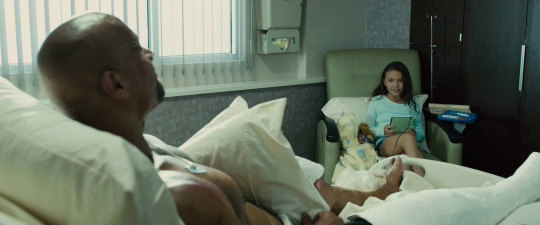

Without the human connection, the spectacle of The Fate of the Furious felt hollow. I should have been wowed by remotely controlled cars barreling through New York City’s streets and raining from parking lots in skyscrapers, but I was bored. I should have been impressed when Dominic and company were racing across ice away from a nuclear submarine, but I was bored and almost nodding off. While the stakes for Dominic as a character were raised with his son’s introduction, the movie itself felt rote, from Cipher’s poorly outlined motivations to a moment that upends the importance of family that is the core of the franchise.
Dominic pays tribute to the bond between his peers that form la familia. However, there is dissonance in the way that Letty, Roman (Tyrese Gibson), and Tej (Chris “Ludacris” Bridges) seemed to have no objection to Deckard Shaw (Jason Statham) joining the team. Shaw murdered Han Lue/Han Seoul-Oh and attempted to kill Dominic, Mia, Brian, and Mia and Brian’s son in Furious 7. Even though Dominic was desperate, contacting Deckard’s mother (Helen Mirren) in order to convince her to persuade Deckard and Owen Shaw (Luke Evans), who has his own disagreeable history with Dominic and company, to save Dominic’s son seemed to betray Han’s memory and to put aside the threats that were made to his family.
The LEGO Batman Movie, Logan, and The Fate of the Furious presented their respective protagonists in non-traditional families. Batman adopts Robin, and they form a trigenerational family with Alfred. Logan becomes Laura’s de facto guardian, and they form a trigenerational family with Xavier. Dominic, Letty, and Dominic’s biological son form a blended family. Indeed, the only traditional nuclear families that we see in these films are the Waynes, which is broken when Batman’s parents are murdered, and the Munsons in Logan.
You could strain to draw a connection between how casually the Munsons are killed to how dystopian the world in Logan is, but the Munsons’ deaths feel almost cruel. From the moment that Logan stops the truck to help them wrangle their horses, the audience begins to wait for the Munsons to die. It gives the otherwise tranquil scenes of Logan, Xavier, and Laura observing what a normal family looks like as they dine together suspenseful tension. Their deaths for doing nothing more than extending hospitality to Logan, Xavier, and Laura felt like a manipulative exercise in cynicism and nihilism. They’re collateral damage in Logan’s violence trap, and the viewer empathizes with Will Munson when he pulls the trigger on Logan after they’ve incapacitated X-24, the younger, feral clone of Logan that was sent to subdue and capture Laura. With his dying breath, Will doesn’t distinguish between X-24 and Logan because they are both monsters that trampled the Munsons’ lives. That the gun’s chamber was empty only emphasizes that violence, even in the cynical world of Logan, isn’t a solution.

Finally, if we accept the notion that becoming a parent is one of the few rites of passage into adulthood left in today’s America, then the other side of that passage is observing your own parents’ decline and eventual death. In Logan, Charles Xavier is suffering Alzheimer’s disease, and Logan and Caliban are Xavier’s sole caregivers. When Xavier doesn’t recognize Logan, he is afraid of him because, to Xavier, Logan is the person who drugs him into unconsciousness. When Xavier is awake and lucid enough to recognize Logan, he berates him for being a disappointment. Xavier’s seizures cause Logan physical pain, and his words cause Logan emotional pain. Xavier is angry at himself and Logan because he needs Logan’s help with something as fundamental as using the bathroom; Logan is resentful for Xavier’s role in the Westchester incident, the physical and emotional pain that Xavier causes him, and the fact that he has to take care of his father figure in his decline.
It was curious to me that three different and big budget films released within two months of each other wove in different ideas about fatherhood into their tales. Each film tried to examine its respective protagonist through the lens of fatherhood and came away with slightly different conclusions. Batman, for as much as he describes himself to be a loner, is character with myriad connections. Logan, another self-professed loner, can’t help but to connect to his daughter when they both do what they do best, even though what they do isn’t very nice and could trap them in cycles of violence. Dominic, a man who talks constantly about his familia, showed that his biological family is ultimately more important to him than the friends and peers around him.
#the lego batman movie#will arnett#michael cera#ralph fiennes#rosario dawson#zack galifianikis#jenny slate#logan#Marvel Studios#warner brothers animation#hugh jackman#patrick stewart#boyd holbrook#dafne keen#eriq la salle#elise neal#the fate of the furious#f8#vin diesel#michelle rodriguez#tyrese gibson#kurt russell#scott eastwood#ludacris#chris bridges#movies#films
7 notes
·
View notes
Text
Get Out (2017)
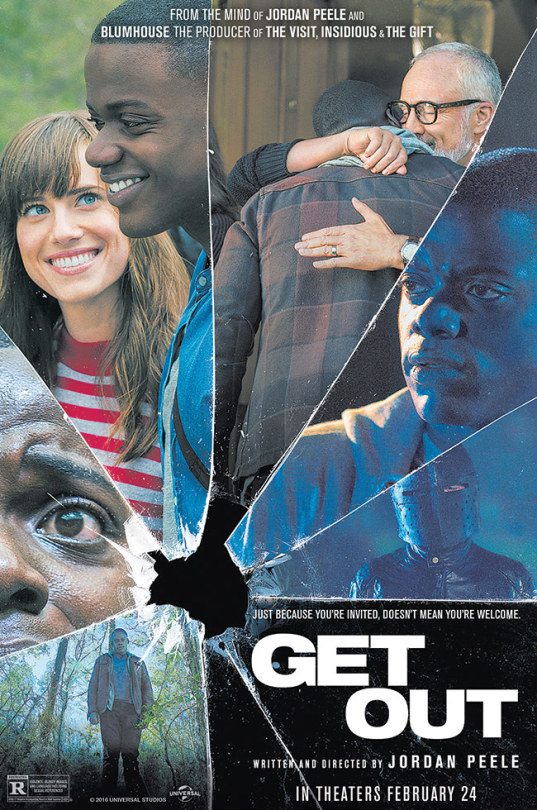
Trailer
It’s taken me a while to process this film and try to figure out what to say about it for no less reason that it feels awkward for an Asian person to comment about a horror film that is couched firmly in the black American experience. Compared to other writers, I felt unqualified to try to analyze what Jordan Peele has extracted from his life and mixed with horror. It was awkward from the start to think that I could feel the danger that LaKeith Stanfield’s Andre Hayworth felt while a car followed him down the street as he tried to walk through a suburban neighborhood at night. I haven’t felt that danger in my life no matter where I am and what time of day it is.
And that’s Peele’s point to a viewer like me.
As an Asian person, I exist in that awkward racial limbo where I’m not perceived as “bad” as black and brown people but will never as good as a white person. I’ll always be considered an outsider in white society no matter how well tailored my clothes are, how expensive my watches and ties may be, how much I try to stay out of the sun to avoid a suntan, or how many different lotions or ointments I use to make my skin “white” and “flawless.”



(And yes, part of the cultural stigma of the suntan is to avoid the connection to outdoor work that the poor do, and fair skin is associated with wealth. But it’s hard to separate race from economic status, especially when you see the range of skin whitening products available elsewhere.)


White remains the standard of beauty for women in America, especially if the woman has Anglicized features (smaller noses, thinner lips, less prominent curves) and straight hair.
Because I’m part of the “good” minority in America, I might be able to date a white woman without causing as many social waves as a black man would. Nonetheless, it is more culturally acceptable for a white man to date an Asian woman than for an Asian man to date a white woman. Except there is no “good” minority in America; there are only short memories and examples from history that are conveniently left out of textbooks. I never read about the Chinese massacre of October 24, 1871 in Los Angeles, in which an estimated 17 to 20 Chinese immigrants were tortured and hanged by a mob of nearly 500 people, in middle school, high school, or college American history texts, even though it is the largest incident of mass lynching in American history. The Chinese Exclusion Act of 1882 gets no more than a paragraph in most textbooks; the Immigration Act of 1924′s ban of Arab and Asian immigrants is not as frequently discussed as the act’s restrictive effects on the immigration of Southern and Eastern Europeans. Franklin Roosevelt’s Executive Order 9066, signed into law on March 9, 1942, primarily targeted people of Japanese ethnicity, and over two thirds (almost 70,000) of the 120,000 Japanese men, women, and children who were evicted from the West Coast of the United States to internment camps were American citizens.
Even if you delude yourself into thinking that you’re safe in America because you’re part of the “good” minority, the American media will remind you that the standard #NoAngel playbook for when a member of the minority in America confronts authority in America will still apply to you. Your personal history will be dragged for any crimes to justify the authority’s use of force against you; you’ll be lucky if the police officer or security agent who used force on you is ever identified, much less charged or prosecuted. Forget about hoping for a conviction, especially if that person is a police officer. You will be told that you should have handled the interaction differently because it will always be your fault that the authority had to use force against you. The media will never take the position that use of force was unreasonable or excessive; you deserve to be treated roughly because you’re a minority.
This brings us to the moment in the film when Peele has Yasuhiko Oyama’s Hiroki Tanaka ask Daniel Kaluuya’s Chris Washington, “Is the African-American experience an advantage or disadvantage?” Why have one minority, the only Asian character in the film, ask a member of another minority if there experience is an advantage? It could be that Tanaka is trying to figure out how much he should bid for Chris’s body since we see Tanaka in the bingo game slave auction later in the film. It could be Tanaka, as one of the “good” ones, is curious and blunt enough to ask that question directly; the question is about two steps removed from asking to touch Chris’s hair, and it encapsulates the microaggressions and racist dehumanization that Chris endures during that party scene, from the golf fan’s question about whether Chris swings a golf club like Tiger Woods or the question from the older woman whose husband is dying about the size of Chris’s penis and his sexual prowess.

Though Tanaka disappears from the film after the auction scene, his brief appearance is enough to highlight that Peele deliberately inserted an Asian character into this film because we Asians, as the model minority, are very complacent about our role in the civil rights struggles around us. Tanaka might believe that he would benefit from the subjugation of a black man as much as the other bidders in that auction, but who’s to say that his family wouldn’t be subject to subjugation one day? The Armitages may have chosen black people to be the vessels by which they and their peers can extend their lives by literally exploiting black bodies because they believe that black bodies are physically stronger, but Stephen Root’s Jim Hudson also points out that they’re selected because black people are cool. Would it shock anyone if Asian people were once selected during the peak of Bruce Lee’s popularity in this scenario because East Asian culture was in vogue? Couldn’t you then connect how easily Asian characters can be portrayed by non-Asian actors to how replaceable minorities are to the white majority?

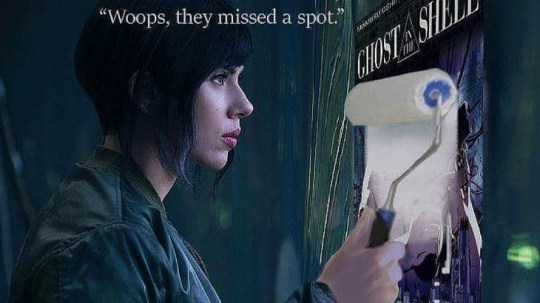

Sometimes, it’s as simple as giving an actor angled eyes or a conical hat to transform a non-Asian actor into an Asian character. After all, black face isn’t in vogue in these times, so you can’t expect a non-black actor to play a black character unless you’re setting out for a deliberate provocation.
Of course, Asians are seen as “the model minority” in part because they’re perceived to be meek and safe. The simple fact that Asians were not forcibly removed from their homes and sold into slavery in America colors the perception that they are a safe minority. There are no distant memories of slave riots. There is no unresolved national shame of slavery. There isn’t the notion that Asians were selectively bred in order to generate the strongest, fastest, and most durable children, which gives Asians a dangerous physical advantage that extends to today. Asian children aren’t referred to as demons or compared to musclebound, larger than life professional wrestlers like Hulk Hogan.
The idea that the Armitages and their peers only want black bodies is directly connected to the idea of slavery, of owning black bodies and counting their labor power and their families as part of the slave owner’s wealth. Peele draws that connection explicitly, whether it’s to extend an Armitage’s life or to replace a failing body for someone’s sexual gratification or simply wanting a black photographer’s eyes because the black person’s artistic skills that were honed through practice and shaped by that person’s experience are irrelevant. Part of the horror lies in how little anything but their physical bodies about Chris and the Armitages’ other victims matter to the Armitages and their peers.
Furthermore, once the Armitages and their peers have taken control of black bodies, those black bodies are then severed from the American black cultural experience. Andre Hayworth is renamed Logan King. Rose’s grandparents assume Georgina’s and Walter’s bodies, but the viewer never sees them interact. Neither Georgina nor Walter interacts with Andre/Logan. The horror also lies in how the Armitages place no value in black culture.

Peele does not invite the viewer to consider the connection between the fact that the United States has both the largest incarcerated population in the world and the highest incarceration rate in the world (USA! USA! We’re #1!) and the disproportionately high rate of incarcerating black Americans compared to white Americans in certain states’ prisons. Nor does Peele invite the viewer to consider the connection between America’s incarcerated population and the economic benefit America extracts by force from its incarcerated population. Nonetheless, a viewer could certainly draw that connection given the context and the information to draw a conclusion about the systemic dependence on black bodies.
The film wouldn’t have stayed with me for this long if it weren’t an effective horror film that subverted expectations in important ways and played horror tropes straight where it counted. Other reviews have focused on how Peele has created a horror film that uses horror storytelling devices to enhance his extrapolation of the terror of the black American experience and punctures the tension with comedy to great effect. This week’s reminder that there is no such as thing as “the model minority” helped to cement what my takeaways from watching Get Out were. It might have been a warning to Chris to save himself, but it’s also an exhortation to me to get out and be active because we’re all in the struggle for civil rights together.

#get out#jordan peele#daniel kaluuya#allison williams#bradley whitford#catherine keener#caleb landry jones#lil rey howery#betty gabriel#marcus henderson#lakeith stanfield#stephen root#erika alexander#keegan-michael key#horror#films#movies#toby oliver
1 note
·
View note
Text
John Wick: Chapter 2 (2017)

Trailer
John Wick: Chapter 2 is the latest zombie film to be released by Hollywood. Though Keanu Reeves did not need to spend hours in the make up chair to be covered in fake rotting flesh, his character, John Wick, is covered in viscera, the results of his battles across the world against his fellow denizens of the underworld. Like the flesh hungry horde of The Walking Dead, Wick strides forward, undeterred by the many injuries to his body, to satiate his appetite for revenge.
The zombie is defined by its single-minded pursuit of bloody, vital meat, and a mere pound of flesh isn’t enough for Wick after Santino D’Antonio (a slimy Riccardo Scarmacio) blew up his house, his treasure trove of memories of his dead wife, Helen Wick (Bridget Moynahan, given nothing to do but to be the object of Wick’s regrets). Santino blew up Wick’s house because Wick refused to fulfill his debt to Santino, claiming that his adventures in the first John Wick did not mean that he was back from the dead (or back among the soon to be dead who don’t know yet that they’re going to be dead, most likely at Wick’s hands). Wick then kills Santino’s sister, Gianna D’Antonio (Claudia Gerini) to fulfill his debt to Santino, which allows Wick to kill Santino for blowing up his house and destroying the last pieces of his civilian life.
Speaking of flesh, it’s said that an eye for an eye makes the world blind. On the contrary, each of Wick’s violent acts in his quest for vengeance turns more eyes toward him until every eye in the world is watching him. He attempted to break the cycle of revenge by offering peace to Abram Tarasov (Peter Stormare), brother of Viggo and uncle of Iosef from the first John Wick, in exchange for his car, the other major fetish of his civilian persona and his wife’s redemptive, life-affirming love. However, he kills Gianna so he can kill Santino. By killing Gianna, he inspires Cassian (Common) to pursue him because Gianna was Cassian’s charge. If Cassian were successful, one of Wick’s acquaintances, such as Aurelio (John Leguizamo), could feel obligated to avenge Wick. Santino assigns his henchmen, including his bodyguard, Ares (a magnetic Ruby Rose), to monitor him and try to kill him after Wick killed Gianna. Wick’s pursuit of Santino ultimately leads him to violate the Continental Hotel’s code, which renders him ex communicado from the world of assassination in which John Wick had played the bogeyman for so long. Wick warns Winston (Ian McShane), the owner and operator of the Continental Hotel in New York and emperor of the world of assassination, that he will kill everyone who tries to hunt him. Nonetheless, it’s an empty threat as every eye, knife, and gun turns to watch Wick as he first walks confidently, then runs in a panic out of New York to try to find sanctuary.

Wick is as much a dead thing as Marvel’s The Punisher, a man who has nothing but his bloodlust for criminals in order to fill the void that his wife’s and children’s deaths left. Santino, like children, shouldn’t have played with a dead thing like Wick. He wanted to resurrect the old death-bringing John Wick so Wick could kill his sister, but he brought back a terrible thing to the world.

However, like horror movies, the world of assassination is strictly governed by rules of conduct. Wick was able to cross from the underworld to the normal world and a civilian life with Helen by performing a mighty feat in the past. Winston points out to Wick that Santino had every right and violated no rules to call upon his debt, sanctified in Wick’s own blood, or for trying to kill Wick when Wick refused after Wick came back from the civilian world into the underworld of assassination to kill first Iosef, then Viggo, in John Wick. One does not cross the boundaries between the normal world and the underworld without paying a price, and the cost for transgressing this barrier is heavier than the gold coins that Wick has to pay Charon (Lance Reddick), the concierge of the Continental Hotel in New York, and other creatures of the underworld, like the Sommelier (a desert dry Peter Serafinowicz), that speak primarily in metaphor. Wick’s gold coins provide him access to these creatures’ services to make him a better killer, to send more people to the afterlife. And when Wick breaks the underworld’s fundamental rule, the sanctuary rule that keeps the Continental Hotel a viable and civil meeting place for the dead, Wick is banished from the underworld.

To reinforce the theme that Wick is some undead monster shambling through the underworld, director Chad Stahelski and cinematographer Dan Laustsen frame Wick in shadow, showing him descending again and again into darkness. First, the last traces of his old life are burned away, and Wick rises from the ground, stumbling like a zombie.

The color that was bleached away in Wick’s civilian life erupts in flames back into his world, and it’s fitting that the first colors a person who craves revenge sees is fiery red. He walks through the sky across a bridge and rises to a rooftop to visit Winston and back down to the ground to visit Santino in a museum. Once he has accepted his quest, he enters a sunless, airless vault to retrieve his black suit and flies through the bright sky into sunny Rome. From here, Wick descends into catacombs near the Baths of Caracalla to murder Gianna and tries to escape again through these resting places of the dead.



Later, Cassian and Wick start a gun battle in Lincoln Center by trying to shoot each other through a water fountain. At first, the civilians don’t even seem to notice these two men shooting at each other, as though the underworld of assassination existed parallel to the civilian world. This sense of parallel existence continues as Wick and Cassian continue their gunfight in the underground PATH concourse at One World Trade Center Station. Wick, as a dead thing, occupies the low ground while Cassian occupies the high ground.


This gunfight in a train station builds on its theme of the impermeability between worlds by alluding to the Mobil Avenue station from another Keanu Reeves movie, The Matrix Revolutions. There, the Mobil Avenue station is a form of limbo (because Mobil is an anagram of limbo) between the machine mainframe and the real world. Here, Wick, a dead man walking, fights so he can continue his quest for revenge, the one thing that gives his existence purpose. He leaves Cassian on the border between life and death at the conclusion of their knife fight on a train, which befits the film’s theme.
In desperate straits, Wick visits The Bowery King (Laurence Fishburne), the king of the underground and leader of people who lead a different kind of parallel existence. The Bowery King’s agents pretend to be the homeless so they can spy on everyone for their king. Meanwhile, he lives above it all, using carrier pigeons to contact his agents across the lower half of Manhattan.

The Bowery King allows Wick to use his underground network to travel in darkness to hunt Santino in a museum, a building dedicated to the past works of the dead. Wick pursues Santino into an interactive modern art exhibit that invites the visitor to reflect on the state of their souls. Gianna asks him before Wick kills her if he wonders if they are damned. When Wick enters the exhibit, his head is wreathed in fire, and there is no question, from the film’s point of view, about his damnation.

In the mirror exhibit, perspectives are skewed and the viewers’ sense of geography is upended. Reflections form illusions, and the only thing we can be sure of is Wick’s hatred for Santino and the violent ends that Santino’s underlings will meet at Wick’s hands. As he did with Cassian, Wick leaves Ares not quite dead, which is unusual for someone who is so precise about his kills that he finishes his enemies with a headshot to make sure that they’re no longer a threat.


Because Wick thinks that he’s a dead man walking, he feels no compunction about breaking the fundamental rule of the Continental Hotel and killing Santino while he seeks refuge inside. For this transgression, Wick is judged by Winston, the god-emperor of the underworld of assassination. For his many other crimes, an angel judges him from on high in the sun.

It’s no coincidence that Winston declares Wick excommunicado, a term that paints the act as almost religious; Wick is excommunicated from his underworld now that his access to his civilian world has gone up in flames. He brags to Winston that he will kill everyone who comes after him, but he knows that he is spiritually and physically damned. He can try to run, but he can’t hide from the eyes of the world.
While Wick might feel godlike because he can snuff the lights behind the eyes of all he fights, he, in his black suit, black shirt, black tie, black shoes (and blackened soul) sticks out in the light, where the mighty and powerful feel comfortable. Wick does his work in the dark, while The Bowery King and Winston can flaunt their power in the open beneath the sun. Wick constantly runs out of bullets during his firefights, and he is bloody and battered throughout the film. He perseveres because his determination and his single-minded focus on killing his enemies as efficiently as possible are almost superhuman, but he is nonetheless confronted with the realities of the magazine and the limits of the human body. The Bowery King and Winston have no such limitations. The Bowery King can act through his agents, while Winston can stop the world with a phone call.

Throughout John Wick and John Wick: Chapter 2, characters ask Wick if he’s back. In the first film, Wick denies that he’s back in the underworld of assassination. He’s only descended because of passion; after all, they killed his dog, the last gift from his life-affirming wife. He only thinks that he’s back because it’s a threat to his enemies.

Once he’s reclaimed his car, the other relic of his civilian life, he buries his guns, his gold, and his black clothes again. He’s dressed in white cotton and corduroy, looking almost mummified when Santino visits him.

When his civilian life has been burned away and driven only by a craving for revenge, Wick hesitates to answer Jimmy, a policeman in his neighborhood who came to investigate the destruction of Wick’s house. Eventually, Wick comes to embrace his descent back to the underworld, but it’s a hollow realization. As he prepares to kill Gianna, Wick is at the height of his power. He spends the assassins’ gold coins lavishly to equip himself for his mission, and he has the Sommelier pick out the best guns for his job. Wick damns himself by killing a woman with whom he was at least friendly, and his power diminishes from there. He accrues wounds, and he struggles to find guns and ammunition as he stalks Santino in the museum.

Finally, the film highlights the border between the civilian life and the underworld of assassination in its use of technology. The assassins straddle the world of modern technology by using contemporary firearms and smartphones, while the foundation of the underworld is laid in old-fashioned phone switchboards, ledgers of contracts and debts, and outdated computers operated by old ladies. While the switchboard operators are young, heavily tattooed women who bring to mind Suicide Girls of yore, the infrastructure feels practically ancient. It might be a living for those women, but death is as old as the universe, so the business of death should feel just as old.
We saw John Wick: Chapter 2 in 4DX seats, which meant that the seats would move in accordance with what was happening on screen. Jets of air were shot at us, and we were sprinkled with water to simulate what the characters were experiencing. It was more distracting than entertaining; part of me was wondering why the seats’ movements didn’t seem aligned with the camera or a particular character’s movement and dreading when the next jet of air or spray would come. Since the seats didn’t surround us, blows to the characters’ chests were simulated with blows to my back, which only proved to be even more distracting. I’m glad to have experienced it, but I don’t really see the appeal other than the fact that they were very comfortable chairs.
#john wick chapter 2#john wick chapter two#john wick#keanu reeves#laurence fishburne#ruby rose#riccardo scamarcio#common#john leguizamo#ian mcshane#lance reddick#bridget moynahan#thomas sadoski#david patrick kelly#peter stormare#franco nero#peter serafinowicz#claudia gerini#chad stahelski#derek kolstad#dan laustsen
1 note
·
View note
Text
Shin Godzilla (2016)

Trailer
It’s funny that I approached two seminal deconstructive works - Alan Moore, Dave Gibbons, and John Higgins’s Watchmen and Hideaki Anno’s Neon Genesis Evangelion - before I had experienced the media and the works that they were respectively deconstructing. I read Watchmen in high school, at a time when I was mostly reading Marvel Comics’s output. I didn’t have the frame of reference to understand how Moore, Gibbons, and Higgins were taking apart the idea of the lone vigilante motivated by a traumatic childhood or the godlike superman. I only realized the commentary Watchmen provided after the fact, and reading the commentary alongside the original text became a sport of its own.
Similarly, when I watched Neon Genesis Evangelion for the first time in college, I had not seen the mecha anime that Evangelion was examining. Just as Watchmen took apart the specific tropes and character archetypes of comic books through parallel characters (Dr. Manhattan is Superman, Nite Owl and Rorshach are Batman, the Comedian is Captain America, Silk Spectre is Black Canary), so was Evangelion dissecting the archetypes found in the mecha anime genre. (Shinji Ikari is the ace teenage pilot, like Amuro Ray from Mobile Suit Gundam, Rei Ayanami is the shy, mysterious love interest who is obedient to the protagonist, Asuka Langley Soryu is the rival, hot tempered love interest and ace pilot.)
It’s striking that both deconstructive works found their analytical powers in presenting “real world” consequences of their genre’s respective and specific tropes through mental illness. Only someone suffering from severe mental health issues could attempt to wage a one-man war on crime by putting on a mask and fighting in the streets. A more realistic version of Batman, Moore, Gibbons, and Higgins, posited, would have to look more like Rorshach. Similarly, a scientist who is able to build giant robots that defend mankind would be even more cynical and monstrous than Astro Boy’s Dr. Tenma; he would look more like Gendo Ikari, who is incapable of maintaining any human relationships and treats everyone around him like dirt.

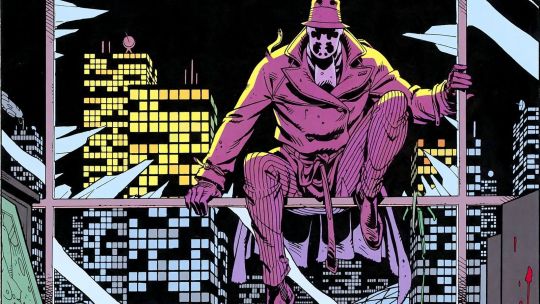
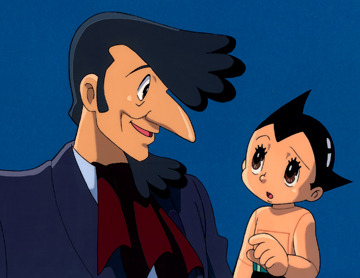

I revisit Evangelion more often than I revisit Watchmen, though Moore and Anno have made it difficult to follow their creative output. Moore’s return to the independent comics publishers to pursue more explicitly sexual, violent, and sexually violent works like Lost Girls, Neonomicon, The Courtyard, and Providence, while Anno’s attempt to retell Evangelion in a new context through the Rebuild of Evangelion movies has stalled with increasingly long delays. Evangelion 1.0: You Are (Not) Alone was released in Japan in 2007, while Evangelion 2.0: You Can (Not) Advance was released in 2009. Evangelion 3.0: You Can (Not) Redo was released in 2012, while production on the final Rebuild of Evangelion film has only barely begun.
Part of the delay in the Rebuild of Evangelion project was Anno’s and Shinji Higuchi’s involvement in Shin Godzilla, which is also known as Godzilla: Resurgence. Anno was contacted to direct Shin Godzilla after falling into depression after completing Evangelion 3.0. Principal photography for Shin Godzilla began in 2015, and the film was released in 2016. It re-positioned Godzilla as a creepy, scary monster, a force of man-made disaster that would serve as allegory for the Japanese triple disaster of the Tohoku earthquake and the subsequent tsunami and the Fukushima Daiichi nuclear disaster of March 2011. (American films will allude to traumatic events in fiction, but more often than not American films will outright try to recreate the traumatic events. You might see Batman vs. Superman: Dawn of Justice, for example, reference the September 11, 2001 terrorist attacks on the World Trade Center, but you’re more likely to see movies that try to recreate that historical event, thereby compressing and distorting history. There’s actually more intellectual honesty in allegorical approach than trying to make a film based on a true story.)


vs.
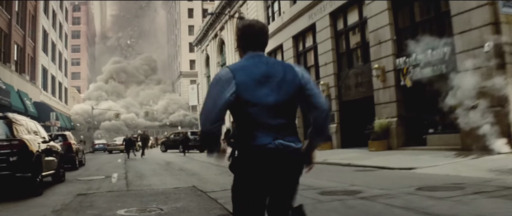


Furthermore, while Anno and Higuchi criticized the Japanese government’s slow response to the disasters of March 2011 through the way actions to counteract Godzilla’s advance would have to flow from the theatre of action up to sub-commanders to deputy ministers to cabinet ministers to the prime minister, who would make a decision that would have to then travel down the same of communication chain before it was communicated, Anno and Higuchi showed great optimism and faith in Japanese infrastructure. Politicians who could be interpreted as weak or concerned about preserving their reputation could be reinterpreted as figures who are willing to give up power so the country could have a fresh start in the aftermath of Godzilla’s cataclysmic visit, figures who are willing to sacrifice their honor for the country’s sake, or figures who are willing to sacrifice their reputations so they could give citizens the best information they had at the time. There’s a lot of moving from one conference room to another that might seem unnecessary to the impatient viewer, but the conversations in those conference rooms are what lead to solutions.
It helps that Anno and Higuchi find sharp angles to film what could have been devastatingly dull conversations in these conference rooms.



Finding these new angles to show men and women working together to solve the Godzilla problem places the emphasis on their humanity and professionalism. Godzilla will not be defeated by sheer force of Japanese or American arms. While Anno and Higuchi uses gorgeous compositions to show the futile attacks on Godzilla by the Japanese Self-Defense Force, they also show the futility of these attacks in widescreen, captivating shots that also emphasize Godzilla’s magnitude.


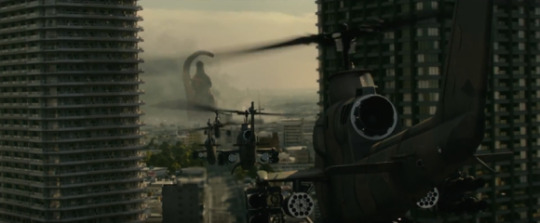



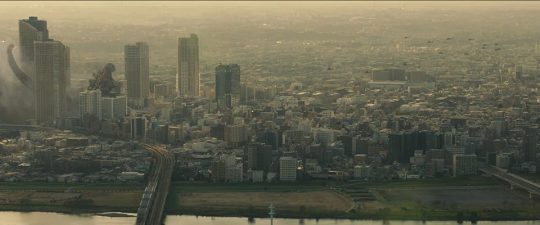


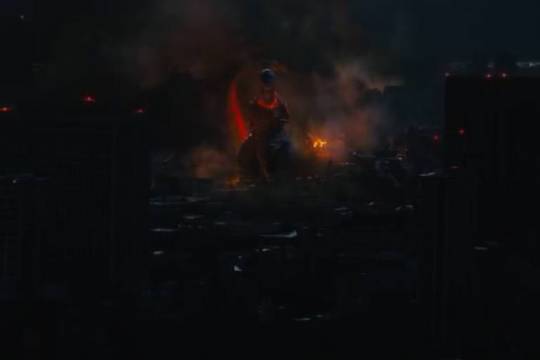
Instead, Godzilla can only be defeated when Japanese industrial acumen, business connections, and American arms are combined to form a strategy that requires self-sacrifice and precise timing, hallmarks of Japanese industrial culture. The hope for Japan won’t be found outside the country. Conventional arms cannot defeat Godzilla. Outlandish non-conventional weapons, like MASER cannons or Mechagodzillas, aren’t feasible. Instead, the hope for survival and the future can be found in Japanese systems like its trains and its industries. It’s subtly nationalist in a way that matches resurgent Japanese nationalism under Prime Minister Shinzo Abe’s regime.
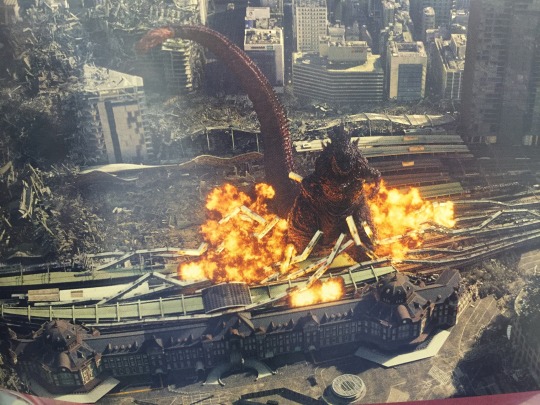

Of course, none of this would have been possible if a team of Japanese scientists and officials who do not conform to their institutions had not been grouped together to find a solution. There’s a power to the bureaucracy, the film argues, in coordinating responses among different agencies and in bringing together the outsiders and non-conformists, and there is a role for the “lone-wolves, nerds, troublemakers, outcasts, academic heretics, and general pains in the bureaucracy” in any organization.
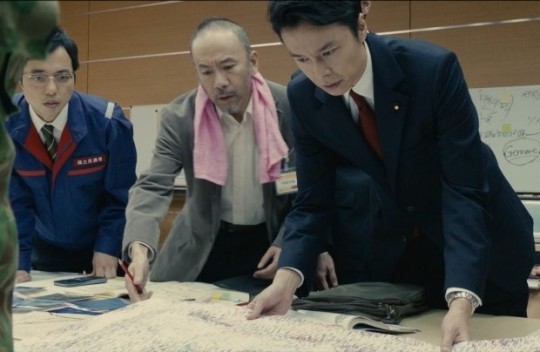
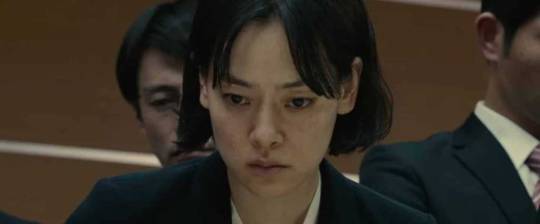
The film is similarly conflicted about Japan’s relationship with the United States. American officials are almost always depicted as faceless voices that demand from afar, sending a half-Japanese liaison, Satomi Ishihara’s Kayoko Ann Patterson, to connect with the Japanese crisis team. Ultimately, Patterson sides with the Japanese government at her own risk at a critical moment, prompting the idea that even those who are of Japanese descent living outside Japan are crucial to Japan’s future. Japanese officials are frustrated by American interference in their affairs; the American government goes so far as to propose using a thermonuclear weapon on Godzilla, which horrifies every Japanese official and even Patterson. In the end, the film taps into the renewed sense of Japanese nationalism by showing that Japanese officials can only move forward to solve the Godzilla problem by going their own way, defying the American attempt to take charge, and solving their problem their way.

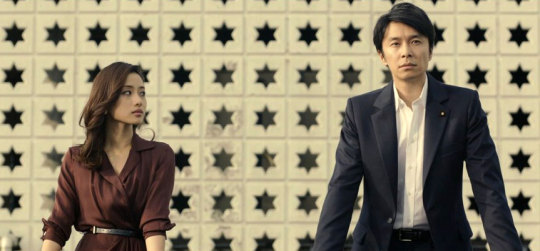
(There’s probably an essay to be written about how the film treats its three principal female characters: Kayoko Ann Patterson, Mikako Ichikawa’s Deputy Director of Nature Conservation Bureau Hiromi Ogashira, and Kimiko Yo’s Defense Minister Reiko Hanamori. Hiromi and Patterson are probably around the same age, and they’re equally outsiders. Patterson is the American half-Japanese liaison, while Hiromi is outspoken and somewhat socially awkward. Patterson is much more conscious about her physical appearance, while Hiromi wears no make-up at all. Reiko stands apart from them both; older than both other women, Reiko is a senior official in the Japanese cabinet and the military’s voice for the Prime Minister.)
Anno, Higuchi, and composer Shiro Sagisu also layer in plenty of homages for Evangelion fans. Based on my impressions, I’ve found these callbacks:
The use of the track “Decisive Battle” from the Evangelion soundtrack to spice up scenes of men and women working in conference rooms
The way the film places a visual emphasis on Japanese trains
The way Anno and Higuchi framed their shots of tanks, aircraft, and artillery pieces bombarded Godzilla in the same ways that they attacked Angels throughout Evangelion
The way they focused on Godzilla’s eyes to show its monstrosity in the same way they focused on Eva-01′s eyes to show its near-humanity
The way the final shot echoed the Failures of Infinity in the Evangelion: 3.0+1.0 teaser trailer at the end of Evangelion 3.33
The way the lights turned out in the underground shelter echoed the way the lights went out during an Angel attack
The way Godzilla attacked all around him echoed the way Ramiel defended itself in Evangelion 2.0
The way Godzilla’s blood plopped to the ground echoed the way various Angels’ blood would fall after they were killed
The way military officials were framed when they released their attacks on Godzilla/the Angels were ineffective
The Japanese Twitter user named “bakashinji” who had an Asuka avatar.


While the film is dialogue heavy, it never feels slow. And it’s a surprisingly funny film, from Godzilla’s googly eyes in its first appearances to the way that an official’s title becomes a visual gag in subtitles because it takes up almost half the screen.

It was everything that I had hoped for from a film by Anno and Higuchi: satirical, strangely hopeful, dynamically shot, wonderfully scored. In other words,

#shin godzilla#hideaki anno#shinji higuchi#shiro sagisu#godzilla#kaiju#hiroki hasegawa#yutaka takenouchi#ishihara satomi
182 notes
·
View notes
Text
Arrival (2016)

Trailer
Denis Villeneuve’s Arrival is secretly two films, but it’s not two films in the way that Memento or The Usual Suspects is secretly two films. Though I haven’t seen Arrival a second time, I’m not sure if there’s a compulsion to see it a second time to pick up clues the way that viewers might be compelled to see Memento, The Usual Suspects, or other puzzle films again immediately. Instead, Arrival’s double-sided nature can be appreciated the moment the credits roll when you realize that Villeneueve, screenwriter Eric Heisserer, and Amy Adams have created a film that attacks the brain and the heart, working one end while secretly tunneling in to ambush the other.

The film begins its offensive on the heart with a sequence rivaling the “married life” segment of Up. Dr. Louise Banks, played by Adams, narrates as we see glimpses of a girl’s life. A baby is born; games of cowboy are played in washed out forests and along lake edges; a teenage girl is sick; a girl is in a hospital bed; the bed is empty. Grief is communicated in cinematic shorthand in a film about language and the importance of communication, and the sequence sets the mood for the viewer from the start.
Informed by this melancholy preamble, we see Dr. Banks exert her linguistic skills on the challenge of bridging the communication gap with the alien Heptapods. Her primary partner in these efforts is Jeremy Renner’s Dr. Ian Donnelly, a theoretical physicist who becomes close to Dr. Banks. Away from the bombast of the Marvel Cinematic Universe and the Bourne franchise, Renner is able to make Donnelly believably nerdy, shedding the tough exterior from those films for the interiority that he achieved in The Hurt Locker and American Hustle.
The anguish is tempered with frustration, from the adverse effect that geopolitics driven by men has on Dr. Banks’s efforts to understand and communicate with (because those are two very different tasks) the Heptapods to the stress that the work lays on Dr. Banks. She is deprived of sleep both because of the demand of the work and because, when she does sleep, she dreams of her daughter.
When there is violence, it is because men have interpreted signs in the worst possible way. An intelligence liaison, played by Michael Stuhlbarg, closes the American camp’s channel because the Chinese and Russian camps have theirs. A soldier bombs the Heptapods’ ship because he interprets his significant other’s terror and the uninformed conjectures from the outside as a call to violent action. A Chinese soldier readies the might of the People’s Liberation Army because he cannot help but think that the Heptapods present a threat even though they’ve done nothing more threaten than show up, spray ink at a screen, or slowly turn their vessels ninety degrees in the air. Bravery is Dr. Banks taking off her orange contamination suit so the Heptapods can see that humans are individuals to open the lines of communication or going to the ship on her own to try to repair the relationship after the bombing.
Though the film tastes of sorrow, it’s probably the most hopeful movie I’ve seen in a while because it emphasizes discovery and interpersonal communication above all else. We experience the type of conflict one would expect from a movie about alien visitors only through far off sound effects and an obscured view; the focus is on Dr. Banks and Dr. Donnelly trying to reach a breakthrough in their communication with the Heptapods. The Heptapods don’t lash out when an explosion detonates in their ship; they turn their ships so that we can’t attack them, and the Heptapods take care to make sure that Banks and Donnelly are safe.

Once upon a time, Amy Adams was the monster of the week on Smallville, a young woman who was obsessed with becoming thinner. By unknowingly ingesting vegetables tainted with kryptonite, Amy Adams’s Jodi Melville’s metabolism was hyper-accelerated, but she developed a craving for fat. I remember next seeing Amy Adams in Sunshine Cleaning, where seeing Adams play with how she portrays emotions on her face was the draw. She also picked up a sense of gritty realness that was, by definition, a departure from the magical benevolence she projected in Enchanted and would show off again in The Muppets. She showed a steely resolve in The Master and American Hustle. In Arrival, she taps a vein of sorrow from Sunshine Cleaning, the strength from The Master and American Hustle, and the compassion from The Muppets and Enchanted to create Dr. Louise Banks that feels emotionally open to the viewer, if not the other characters. Villeneuve turns to Adams consistently as the film’s emotional barometer, relying on her to set the emotional tone for how the audience should react by showing how she reacts to something that Villeneuve and cinematographer Bradford Young will show us shortly.

Thus, I was gripped by the film’s sense of grief, wonder, and optimism. Given what we’re told in the preamble, I was invested in Dr. Banks, thinking that this was a story of a woman finding catharsis in her monumental work, establishing first contact and communicating with an alien species, building a relationship with them instead of blowing them away and maybe taking their technology for our own so we can backwards engineer them for our own benefit.
Until we got to resolution, and I could see the other film that Villeneuve had been making right under my nose. I don’t normally offer spoiler warnings, but this is one case where I will put them in huge letters. Suffice it to say that I could have recommended the film without reservation even without the twist.
[BE ADVISED. SPOILERS HENCEFORTH.]
The Heptapods didn’t share the technology for interstellar travel with humanity, but it shared an even more important tool: a language that could allow the user to see beyond the moment and perceive time in its entirety. Working with the Heptapods’ language allowed Dr. Banks to receive information from the future, creating causality loops to ensure that a future where humanity avoids attacking the Heptapods comes to pass. Because Dr. Banks is able to receive information from the future, we are led to conclude that the scenes involving her daughter are actually glimpses at her future. Dr. Banks isn’t a grieving mother and divorcee at the beginning of the film; she will have a child with Dr. Donnelly in her future, and they will eventually separate. Her daughter will eventually die. But it hasn’t happened yet for Dr. Banks.
Villeneuve uses cinematic language to lead us to that conclusion and does not challenge our assumption until he reveals the twist at the very end. The very act of placing that montage at the beginning of the film makes it seem like the chronological start of the film’s events. What we see first must surely be what happens first in the film even though viewers everywhere are familiar with the idea of flashback. Because there wasn’t an obvious signal in Adams’s appearance, the common point between the preamble and the rest of the film, that showed that she was older in those scenes, we are led to believe that they took place in Dr. Banks’s past. Furthermore, Banks spoke in the past tense during the preamble, so we’re led to conclude by the virtue of how English is constructed to assume when the preamble took place. The preamble primes the viewers to make this assumption and carry that assumption to draw conclusions about Dr. Banks. The viewer is then invited to examine the inherent biases they have in drawing those conclusions about Dr. Banks. Did we assume that Amy Adams was projecting sadness when she could have just been projecting a serious professionalism? If we did assume, why did we make that assumption? Was it because she’s a woman?
I didn’t feel cheated by the twist; instead, I was impressed by how deftly my own understanding and assumptions had been used against to build the twist. It created a second film; this adventure with the Heptapods becomes the prologue to the relationship that Banks and Donnelly will have. It’s a brilliant manipulation of the viewer’s own awareness of cinematic language, underlying assumptions that reinforces the film’s themes about the how language itself is the greatest barrier to effective communication.
#arrival#films#movies#amy adams#jeremy renner#michael stuhlbarg#denis villeneuve#bradford young#johan johansson#eric heisserer
9 notes
·
View notes
Text
Star Wars: Episode VII - The Force Awakens (2015) and Rogue One: A Star Wars Story (2016)

The feeling of inevitability is a delicate tool in crafting a story. At its best, it forms the feeling of a clockwork machine, like the pieces fit where they are supposed to, sometimes to the amazement of the viewer or reader. “Of course it ended that way,” the person might say, “there was no other way it could have finished, and I understand how we got here.” When it backfires, inevitability is fatalist; “That’s the only way this could have happened because this movie is one gear in a multi-film cinematic machine, and it had to set up a sequel two years away and position the character for a cameo in the movie that’s coming out next year.”
The balance is especially tricky with a film that extrapolates its plot from embedded history, embedding the story in an event in the past that everyone seems to know even though no one has ever seen it. The viewer knows how the story they’re watching ends. The focus, then, shifts to how it arrives at the known conclusion. You could argue that there’s more narrative space in the prequel than in the sequel.
Star Wars: Episode VII - The Force Awakens should, in theory, feel creatively adventurous. True, it’s resurrecting a franchise after Episode III: Revenge of the Sith after a decade of recriminations and debate about how Episodes I-III served the story of Anakin Skywalker, but it was introducing a new quartet of characters. Three of the four characters could have stories outside of the series’s larger tale about Anakin Skywalker; Episodes I-III charted his downfall, and Episodes IV-VI charted his redemption through his son. Instead, the film’s crux is built on what went wrong with Kylo Ren, the son of Leia and Han Solo, Luke Skywalker’s nephew and Anakin’s grandson. Rey, Finn, and Poe could be the main actors in Episodes VIII and IX, but Episode VII has already placed the emotional heart in Kylo Ren and whether he could still be redeemed. What happens to Rey, Finn, and Poe wouldn’t be as important as Skywalker family drama in the Star Wars universe. Regardless, The Force Awakens ended the way it had to so Episodes VIII and IX could come out. And since those are tales yet to be told, the inevitability is tainted with a lackadaisical sense of waiting for the rest of the story to get to where you know it has to go.

In Rogue One, we get a taste of how everyone else gets trampled under the Skywalker family drama; it mostly tastes like ashes. Anakin, as Darth Vader, set the galaxy ablaze, and now characters like Jyn Erso have to sleep in the fire and scratch out an existence in the dirt. Every character we are introduced to in Rogue One is taken off the board by the end of the film. In that way, the shallowness of these characters’ personalities almost makes sense. We know these characters more by their function than who they are; Bodhi Rook is the pilot; Baze Malbus is the one with the big gun; Chirrut Imwe is the blind monk and melee specialist; Jyn is the inspirational leader; Cassian is the soldier. Jyn’s change of heart and character might seem sudden, but she is what the story requires her to be in this ensemble. She’s used up by the story by the end anyway, so it probably wasn’t worth the narrative effort to give her or the others a sense of interior existence. The story ended the way it had to so it could lead to Episode IV.
Because Rogue One’s inevitability is part of its narrative rather than The Force Awakens’s metanarrative inevitability, there’s a thrill to seeing how Gareth Edwards delivers us to that point. There are things about the journey that are sure to annoy and did annoy me as I watched the film and after: using politically charged imagery, like tanks rolling through dusty, sandy streets, without actually exploring how that affects Jyn or Cassian or any of the Rebels who attacked that Imperial convoy; the narrative pointlessness of the trip to see Saw Gerrera; showing bodies on both sides caught in explosions but keeping blood off the screen; the out-of-nowhere change in Jyn from rogue to inspired and inspirational Rebel; the shorthand in how Chirrut, Baze, and Jyn become close enough for Baze to call her “little sister.”
It doesn’t hurt that Edwards is a more creative director than JJ Abrams, whose visions is better applied to smaller scope projects like 10 Cloverfield Lane than a grand space opera. AT-ATS appearing from the mist and towering above trees in Rogue One recall images of Godzilla and shape the dread that the characters and the viewers feel. Abrams’s shots of Starkiller Base feel small, like we’re watching an episode of a syndicated science fiction drama instead of a feature film with a budget in the hundreds of millions. It’s dismissive and maybe a bit unfair to say that Abrams tries to hide his background directing television with cheap tricks like lens flare, but Abrams doesn’t work with same sense of cinematic scope that Edwards does.


I wish Edwards and screenwriters Chris Weitz and Tony Gilroy had treated the story, if not the editing, more delicately so the story in the first half doesn’t feel so disjointed. Jumping from one planet to another in rapid succession felt perfunctory, and Saw Gerrera left more questions than answers. But there was a buzz to watching Rogue One that was absent in The Force Awakens, which just left me impatient for the inevitable sequel.
#star wars#the force awakens#rogue one#felicity jones#diego luna#ben mendelsohn#donnie yen#mads mikkelsen#alan tudyk#riz ahmed#jiang wen#forest whitaker#gareth edwards#harrison ford#mark hamill#carrie fisher#adam driver#daisy ridley#john boyega#Oscar Isaac#lupita nyong'o#andy serkis#Domnhall Gleeson#anthony daniels#peter mayhew#max von sydow#iko uwais#j.j. abrams
8 notes
·
View notes
Text
Dr. Strange (2016)

Trailer
The other day, I was wondering why the antagonists in Marvel Studios’s films are often so forgettable and that the only way a compelling antagonist could be generated was to place the heroes against each other, resulting in something like the conflict between Captain American and Iron Man in Captain America: Civil War. It occurred to me during the post-credits scene in Dr. Strange featuring the title character and Thor that Marvel’s cinematic stories are often interchangeable, a way of modular storytelling that remixes the pieces in slight variations in order to make stories into commodities. A man (and so far, they’ve only been men) is hoist on his petard (Tony Stark is hurt by his own weapons; Stephen Strange’s talented hands are crushed in a car accident that he was responsible for; Thor’s lust for battle results in his exile from the kingdom he was defending; Peter Parker’s momentary shirking of civic responsibility indirectly costs him his father figure, breaking up his social atomic unit) and must learn to accept his old mistakes and new identity (Stark is now a technological defender; Strange is now a mystical defender; Thor now defends his home kingdom and Earth; Parker cares about all of New York City, not just his friends and family in Queens) and come out a slightly better storytelling engine. The pieces have the same shape, even if they don’t have the same color (science fiction, Eastern mysticism, Norse mythology) or the same taste (Iron Man is a more bittersweet than Thor, looks better than it tastes, while Spider-Man looks like a thin, New York slice of pizza).
Because Dr. Strange is told from the Marvel Studios’s template, the film feels comfortable and familiar even when the visual palette, full of neon purples, electric greens, and searing oranges, and the film’s gimmick of turning the scenery by ninety degrees to disorient both the characters during their battles and the viewer during fight scenes dazzle the eyes. We know that Dr. Strange will be humbled by a personal setback, redeem his estranged romantic relationship, and become a flawed but vital defender of his fellow man, so our attention can wander elsewhere to capture the visual tricks that director Scott Derrickson, cinematographer Ben Davis, and Industrial Light & Magic and other visual effect companies had built. For the most part, it works; nothing is so apparently a product of green screen magic that it took me out of the moment and broke my suspension of disbelief. The time manipulation sequence in Hong Kong is the film’s highlight, carefully crafted to force the viewer to carry a sensation of time as it goes forward and backward simultaneously.
Instead, it’s the way that the modular storytelling is stretched and bent to fit this particular set of pieces that interrupted my connection with the film. It starts with something as simple as the way that Dr. Strange and Tony Stark fashion their facial hair and goes to the way that each man holds his hands up to the way that their mentors have to sacrifice themselves in order for Dr. Strange and Iron Man to emerge from their Asian birth holes to the way the film has to tell us that their respective women are important to them even though we don’t ever spend enough time with them to get a sense of their interior lives. Dr. Strange’s Ancient One is Iron Man’s Professor Yinsen; Rachel McAdams’s Christine Potter in Dr. Strange is Gwyneth Paltrow’s Pepper Potts in Iron Man.


Once you can see the template, the power of the story is lost.
And since Dr. Strange is the character’s cinematic debut in Marvel Studios’s grand work, there has to be a set-up for the next adventure and the next solo film. The set-up for the next adventure, a supporting role in the next Thor film, is more compelling than than the set-up for the next Dr. Strange film, which pits Strange against his former battle companion and colleague, Mordo. Mordo’s fall from colleague to enemy is underdeveloped because the focus is on Strange’s transformation. And you could justify that by saying that lives progress and people change all around us without our noticing, but this film doesn’t pay enough service to Mordo’s change to establish the hook for the sequel, which makes the sequel a harder thing to sell to viewers. If the next iteration is harder to sell because the first version failed to lay out the case properly, then this film partly failed as a commodity, which is the primary motivation for Marvel Studios to make this product in the first place.
Mads Mikkelsen as Kaecilius is a cypher, and his sophisticated brand of menace is wasted in this film. Tilda Swinton’s Ancient One is the best thing about the movie, and while I don’t dismiss that it’s, at the very least, annoying that a character that was born in the Himalayas in the source material changes origin and becomes a Celtic woman, the quality of her performance makes the change a little easier to swallow. In a way, it’s also poetic that an ostensibly Asian character is twisted into a character played by a non-Asian actor since that’s at the core of Dr. Strange’s character. Stan Lee’s and Steve Ditko’s interpreted Eastern mysticism’s exoticism by adding a vowel here and a consonants there to form words and names that sound just a little weird to the American ear (Agamotto, Kamar-Taj, Kaluu, Dormammu, Watoomb, or Vishanti) without actually representing how Asian languages are structured.
Cumberbatch does his best with the Marvel protagonist template, and he certainly sells Strange’s arrogance. However, despite the amount of time that we spend with his Stephen Strange, I never got a sense of the character’s interior life. He sought the Ancient One because he wanted to fix his hands because his identity was rooted in his pride in his work. The flip from arrogant surgeon who loves the limelight and the fast life to a quiet mystical defender of mankind working in the quiet places felt like it was missing a step, more alchemy demanded by where the character must be rather than a natural growth of where the character should be after the sum of his experiences that we see on screen. Some of his quips, particularly during his interactions with Wong, felt like Tony Stark’s lines slightly modified for this setting. This sense that Dr. Strange is a lesser Iron Man, with the unconvincing turn from Chiwetel Ejiofor’s Mordo to set up the sequel, left me with the sense that Dr. Strange might be a better supporting character than protagonist. Again, if the goal was to make the story into a marketable commodity, it didn’t work because I’m not sure I would be interested in seeing another Dr. Strange film.
#benedict cumberbatch#chiwetel ejiofor#tilda swinton#rachel mcadams#mads mikkelsen#michael stuhlbarg#dr. strange#marvel studios#films#movies
0 notes
Text
Train to Busan (2016)
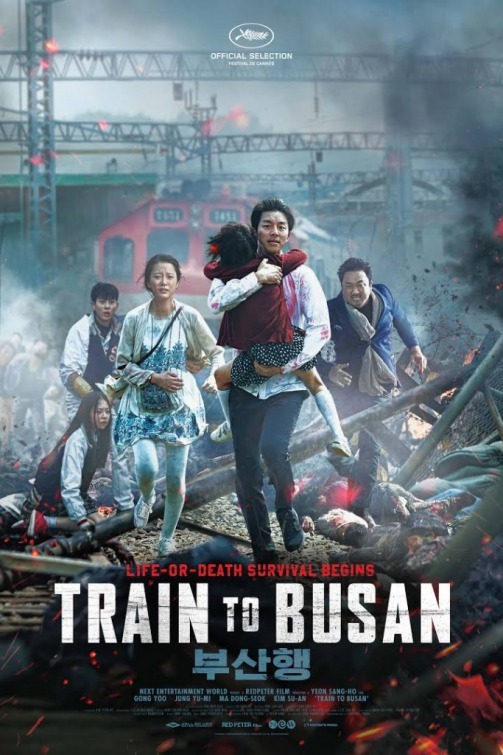
Trailer (Honestly, don’t watch it. I’m not opposed to trailers that spoil, but this trailer gives everything away.)
Art is society’s mirror, and horror films are best equipped to reflect social stress and upheaval. Because horror doesn’t need to rely on spectacle, it can be done cheaply and quickly. The DIY spirit of horror is strong, and it presents an effective medium to satirize our culture with a dose of adrenaline.
While the United States melts down in the aftermath of this year’s presidential elections and all the hot takes that have come with it, South Korea is undergoing its own period of political upheaval, with protesters demanding the resignation of President Park Geun-hye because the Park administration has been tainted by scandal since the 2012 presidential election, when Park’s opponents accused the Korean National Intelligence Service of promoting Park’s campaign by posting articles favorable to Park and slanderous to her opponents online. She’s avoided questions during press conferences and created a governmental commission to monitor and prosecute social media critics of Park after the April 2014 accident of the Sewol ferry. The latest controversy surrounds her relationship with Choi Soon-sil, who had accessed confidential documents despite possessing no official government position because she was a close confidante of President Park. She’s also accused of extorting hundreds of millions of dollars from Korean companies and embezzling these funds. Park’s aides have been arrested for abusing their power and helping Choi, and they have claimed that they were simply following presidential orders. In response, Park has fired members of her cabinet and the prime minister of South Korea to deflect the public’s criticism, which has culminated in the massive peaceful protests that have captivated Seoul in November. The mess gets messier because neither the opposition nor the ruling party is prepared for an election to replace Park, who has stated that she plans to remain in office until her term is finished in February 2018. Complicating matters further, Ban Ki-moon, the UN secretary general, is rumored to be a potential South Korean presidential candidate.
It’s no shock then that South Korea has also seen a horror movie boom with films that poke at institutions, from the boarding school system to government media, that form the foundation of South Korean society. To my mind, no horror sub-genre is as effective as grasping wide-spanning anxiety like the zombie film. George Romero’s Night of the Living Dead emerged from the 1960s zeitgeist, while his Dawn of the Dead showed the apprehension and pessimism of the 1970s. Yeon Sang-ho’s Train to Busan is the film that Marc Foster and Brad Pitt wished World War Z could have been, a smart combination of light social satire, melodrama, and horrific thrills that leverages the excitement of watching an epic, cataclysmic collapse with archetypal personal stakes. We can see cities explode and burn and understand it at an intellectual level, but Yeon also makes sure to put immediately identifiable personal relationships between father and daughter, husband and wife, sisters, teenage lovers, and baseball teammates at risk to anchor the action.
The film’s construction begins by focusing first on one of these personal relationships, the strained connection between Gong Yoo’s Seok-woo and Kim Su-an’s Soo-an, father and daughter who are frosty at best with each other because Seok-woo is a self-obsessed workaholic. Hints about a wider problem escalate from online articles glanced through by Seok-woo to emergency vehicles racing to a burning penthouse in the distance, but our concern is more attached to the awkward moment when Soo-an unwrapped her birthday present, which is the same video console that Seok-woo gave her for Children’s Day that year.
To make up for this faux pas, Seok-woo agrees to accompany Soo-an on her trip on the eponymous KTX high speed train to Busan to see Soo-an’s mother/Seok-woo’s estranged wife. We are quickly introduced to the other passengers in thumbnail sketches that will serve as characterization, from Choi Woo-shik’s Young-gook, a high school baseball player who is the reluctant object of Ahn So-hee’s Jin-hee’s affection. Ye Soo-jung’s In-gil and Park Myung-sin’s Jong-gil are elderly sisters, and we are told that one is more compassionate than the other because In-gil offers Jong-gil a boiled egg. Seok-woo tells Soo-an that he sees everything that she does even when he’s not physically there, but he doesn’t notice that she’s left her seat because he fell asleep on the train. Ma Dong-seok’s Sang-hwa’s earthy warmth is painted in his brief interaction with Soo-an; this interaction is compared to Soo-an’s interaction with Kim Eui-sung’s Yong-suk, a condescending businessman who tells Soo-an that she will end up homeless if she doesn’t concentrate on her schooling. In a matter of minutes, Yeon sketches the characters that we’ll follow, their characters’ starting points, and most importantly, the geography of the train. Seok-woo, Soo-an, Yong-suk, In-gil, and Jong-gil are in the first class car, while Young-gook and Jin-hee are in a car with their high school classmates. Sang-hwa is waiting for his pregnant wife, Jung Yu-mi’s Seong-kyeong, to come out of the bathroom, a bathroom that Soo-an passed.
Society’s collapse remains in the periphery as a train attendant misses a sick woman stagger onto the train behind his back. We watch with Soo-an that same attendant get tackled to the ground by someone, but Soo-an and we are unable to see any more because the train is pulling away from the station. We see news reports on the train’s television about rioting in Seoul, and the viewer is led to make the connection between the rioters and the sick woman to tease the violence that will follow.

When the violence is unleashed, it’s shocking even though it’s expected. The virus quickly spreads from the sick woman to a train attendant to cars of passengers, and panic spreads even faster. Seok-woo admonishes Soo-an for giving her seat to Jong-gil, a show of cultural deference to the elderly, and emphasizes to her that she should look out for herself, especially in times like these. Soo-an strikes back with a reminder that her grandmother, Seok-woo’s mother, often had pains in her knees and that Soo-an’s mother left Seok-woo because he was a selfish man. It should surprise no one that Seok-woo will be forced to reconsider his worldview, especially when Seok-woo is presented with a vision of his future in the snotty executive, Yong-suk.
It should also surprise no one that Yeon will stick it to authority, with a heavy-handed montage of a government official at a press conference urging citizens to remain calm and to trust the government in the face of this crisis as the passengers see panicked messages on social media about violence and collapse across the country. Handheld videos show the zombies hanging off of police helicopters that fly over smoldering city blocks. This feels like a direct response to how the media reported the government line that everyone in the Sewol ferry accident survived when, in reality, 300 people had died when the ferry overturned. Investigators uncovered that the ferry’s owners overloaded it to save money and that the captain and crew saved themselves and rescued no passengers in their lifeboats.It also feels like a response to how the South Korean government officials refused to disclose how a Middle East respiratory syndrome outbreak would be contained and instead demanded that the citizenry trust them.
The distrust of authority is made personal again when Seok-woo, described by Sang-hwa as a “bloodsucker” who “leeches off others” to make his living, tries to circumvent a quarantine by calling his connection in a city’s police department and asking for special treatment for him and his daughter. The train crew will defer to the businessman aboard, the only person willing to assert authority in the face of collapse. The cozy relationship between business and the government is just as much a poison already present in society as the government’s need to redirect and deflect criticism and concerns in order to maintain control, and they present as great a danger to everyone as the ravenous hordes.

Lee Hyung-deok’s agile cinematography, enhanced by Yang Jin-mo’s editing, keeps the film’s pace ferocious, and Jang Young-guy’s score deftly flips from carnage to melancholy. The action is give enough time to breathe, and the characterization is broad enough to fit in between moments of violence. These fast zombies are smart enough and fast enough to create a spectacle that I hadn’t seen in the genre before, and the film mostly plays fair with the rules that it sets with the zombies.
It doesn’t feel like a coincidence that Yeon set his apocalyptic film with a theme about class conflict aboard a train after Bong Joon-ho and Park Chan-wook’s 2013 film, Snowpiercer. Perhaps a train makes an attractive setting because the action, by the enclosed nature of the train, becomes a pressure cooker that forces everything to come together. Or, perhaps a train is attractive because it’s a combination of classes, from first class passengers to passengers in the rear of the train, that creates the field for stories about class conflict. A train would also allow to balance the spectacle of watching widespread collapse across swathes of geography with an on-the-ground immediacy that would be impossible if viewed from the air.
It’s easy for horror films with a political theme to descend into cynicism, and I was fully prepared for Train to Busan to end on the most cynical note possible. In hindsight, I should have known better. The survivors are lucky to make it as far as they do because of the sacrifice of others who are responsible enough to overcome their panic and base instincts in times of crisis. Ending the film cynically would betray this theme and the film’s exhortation that our skepticism about authority has to be balanced by human compassion and empathy.
#yeon sang-ho#gong yoo#jung yu-mi#ma dong-seok#kim su-an#kim eui-sung#choi woo-shik#ahn so-hee#train to busan#horror#films#movies
0 notes